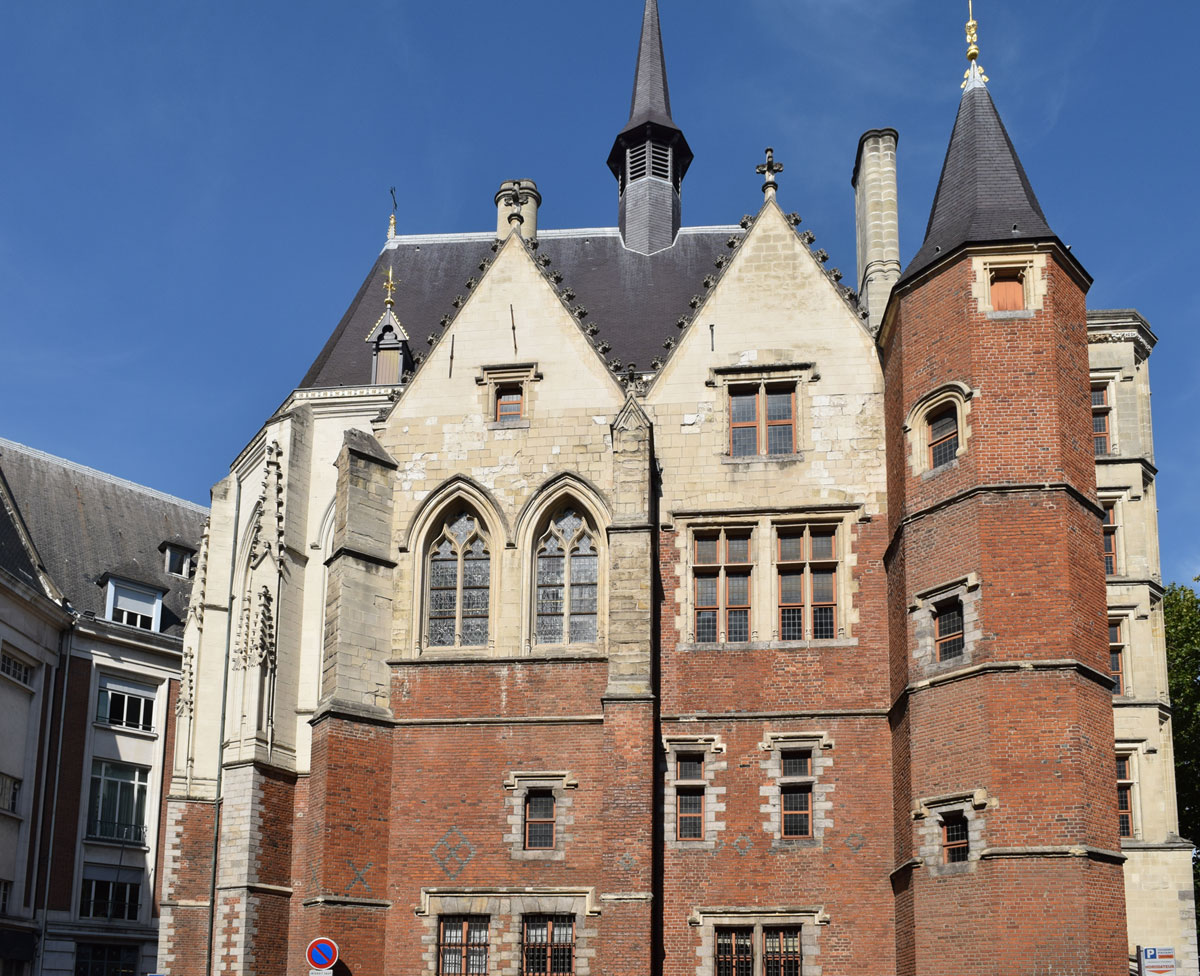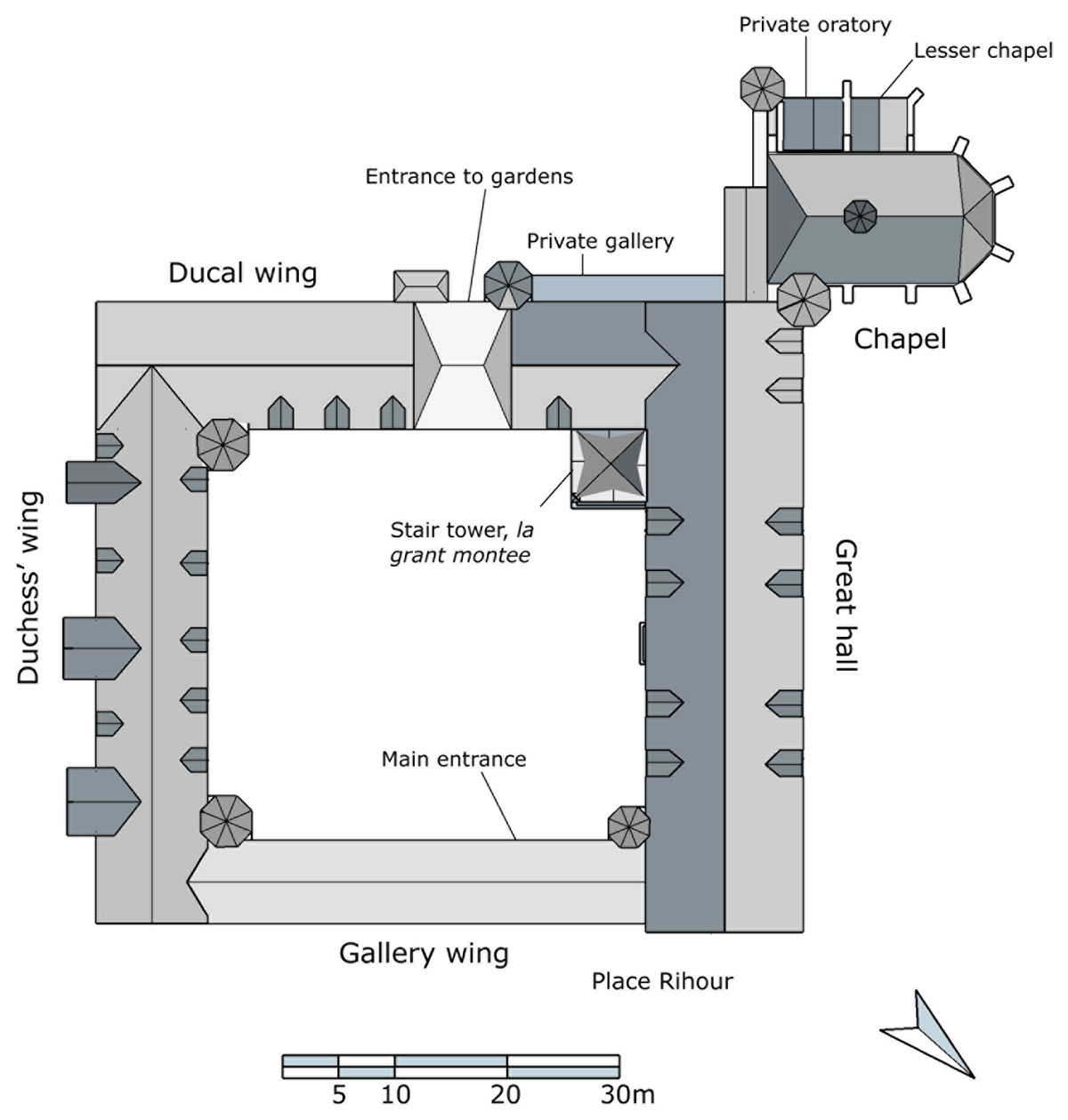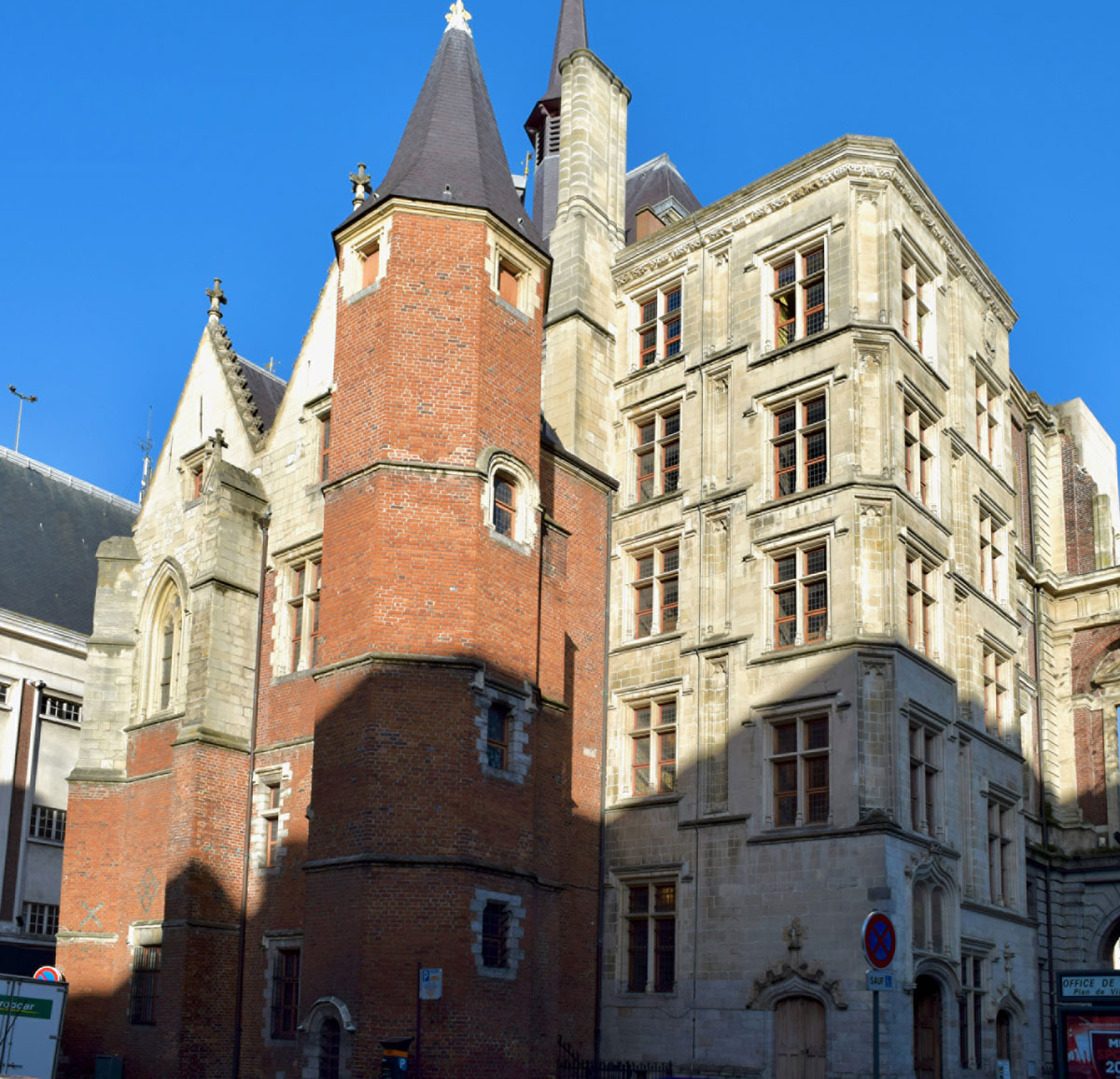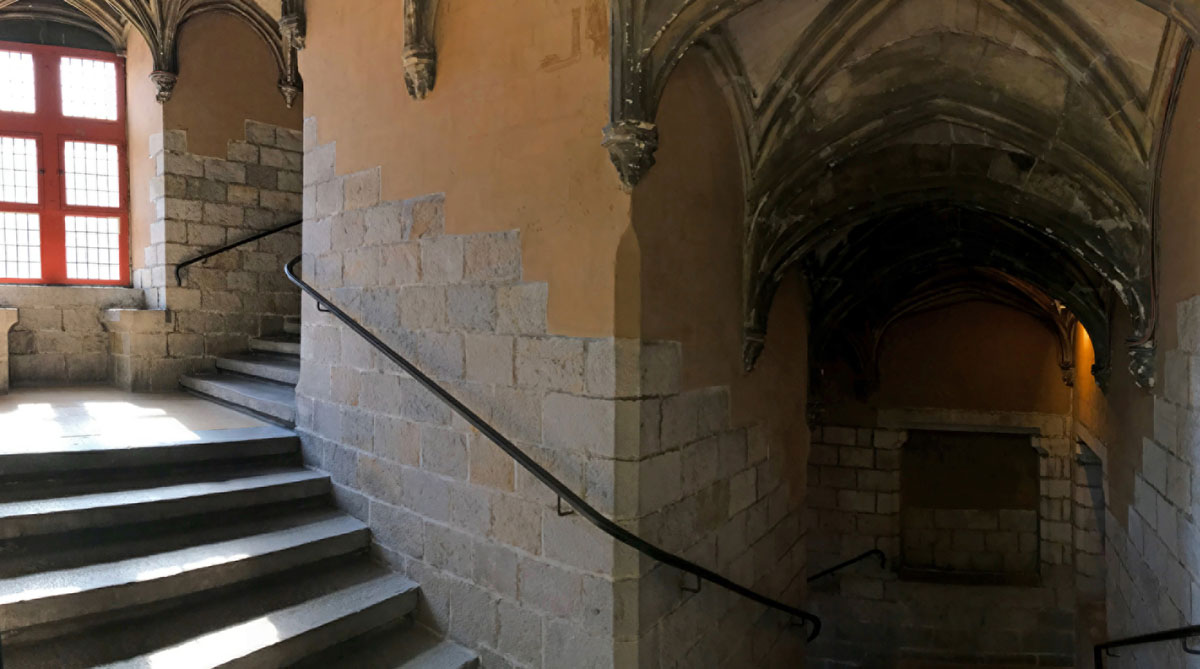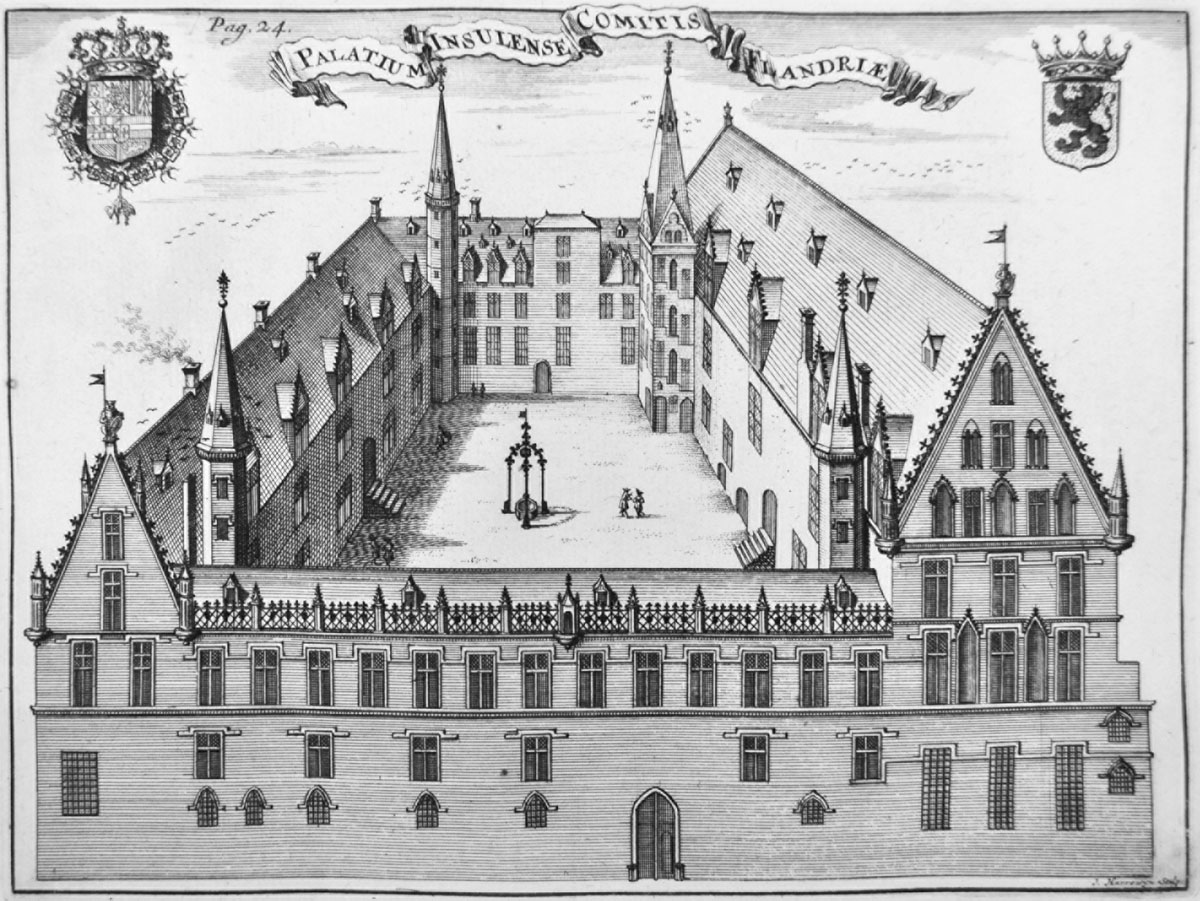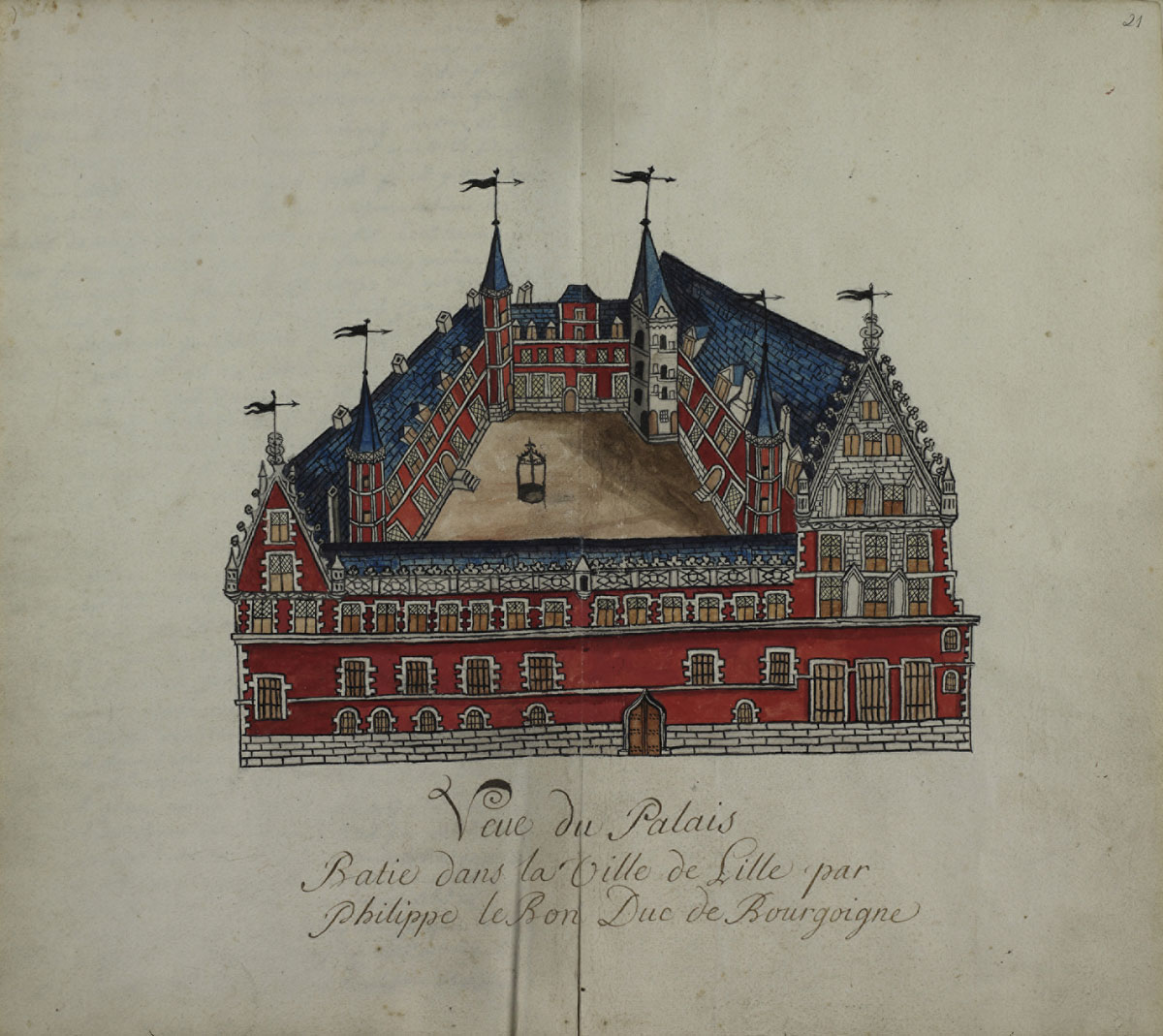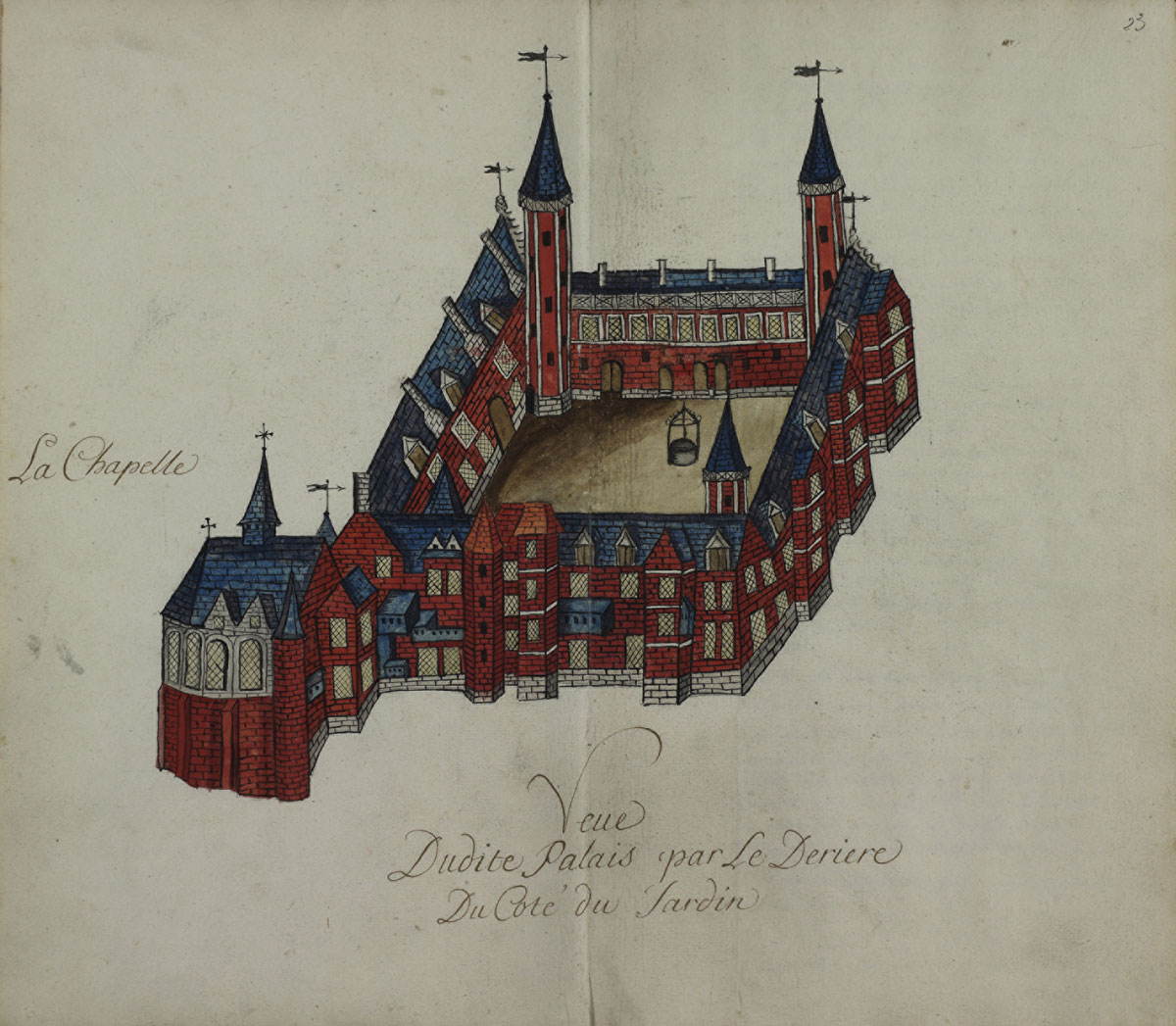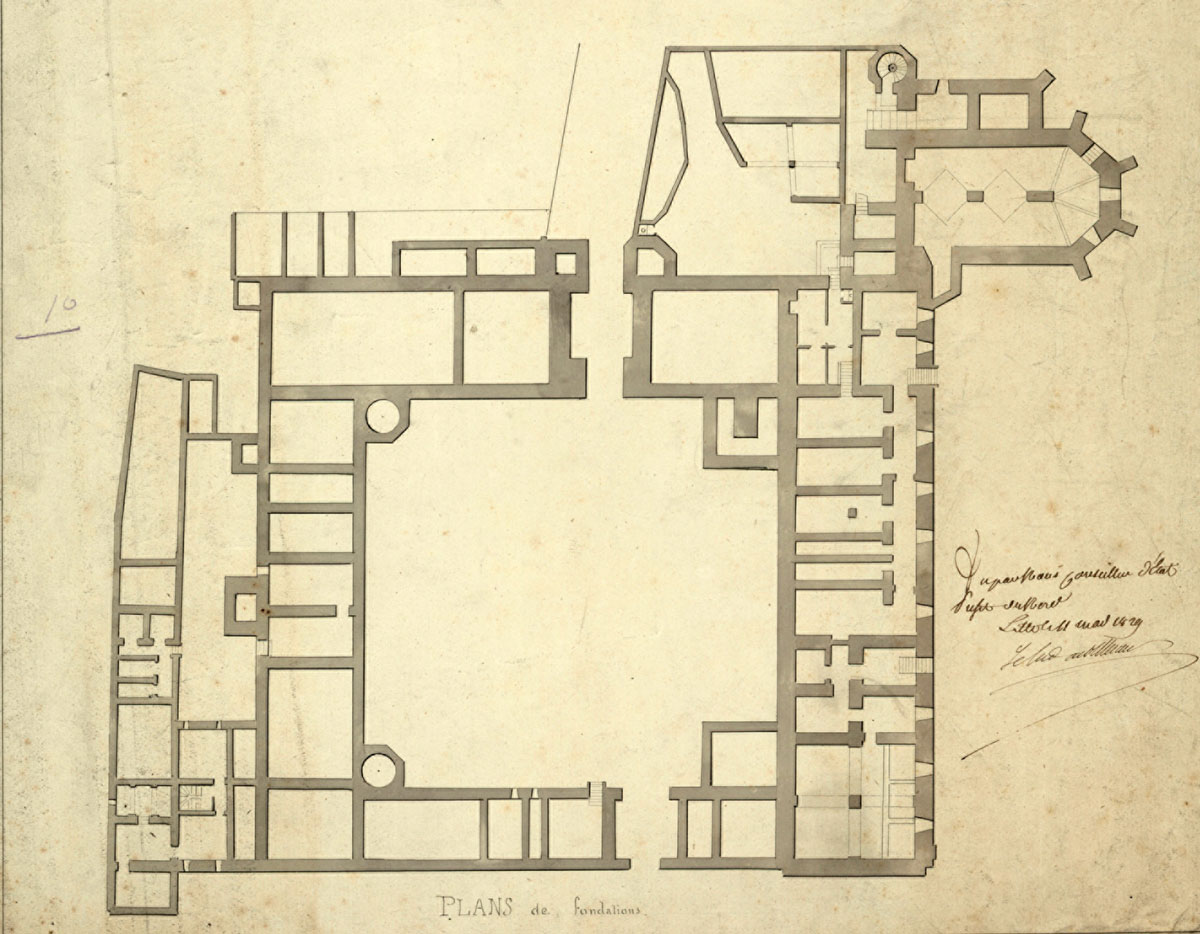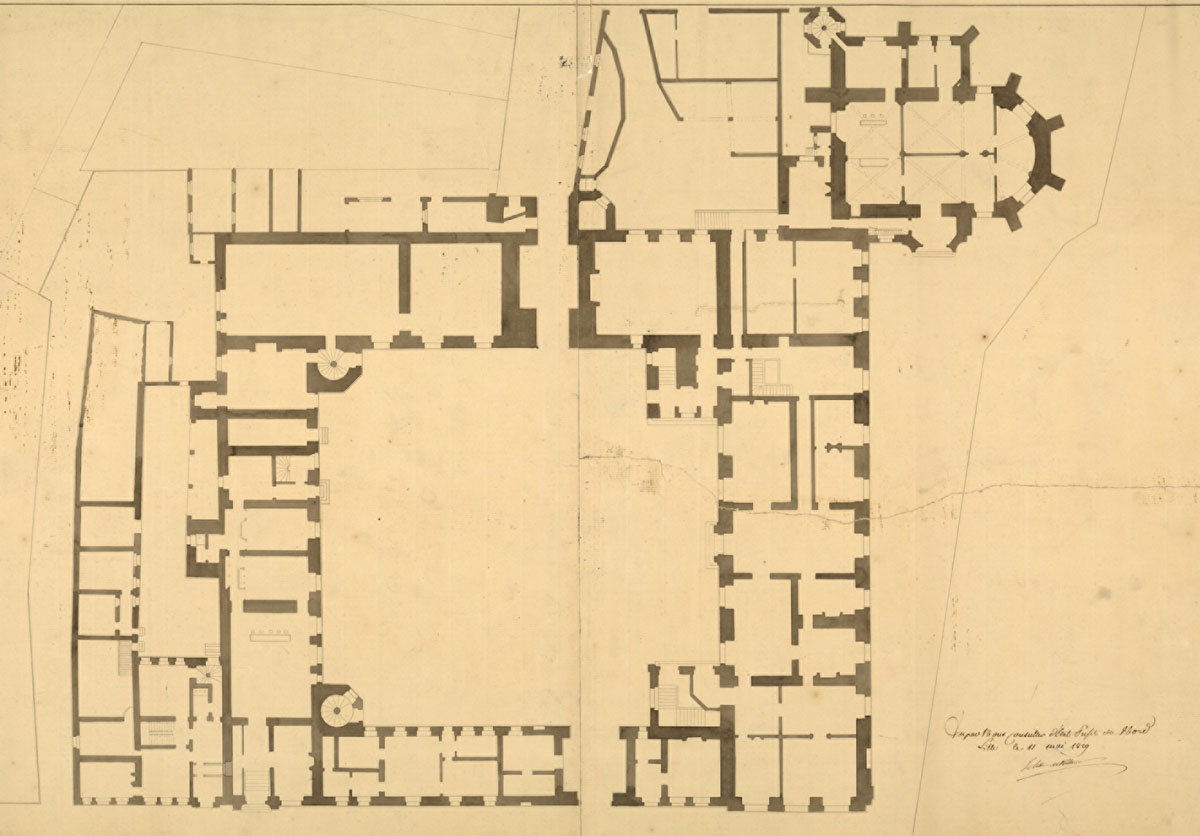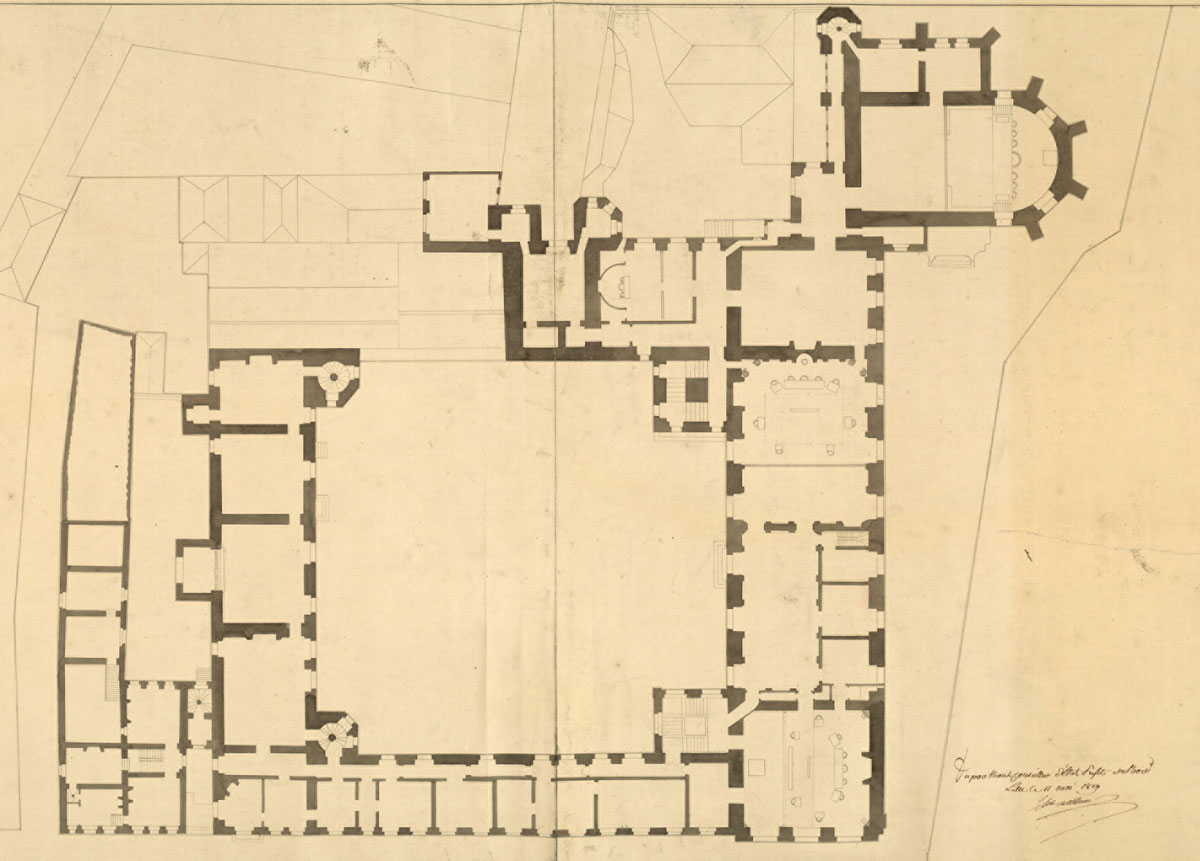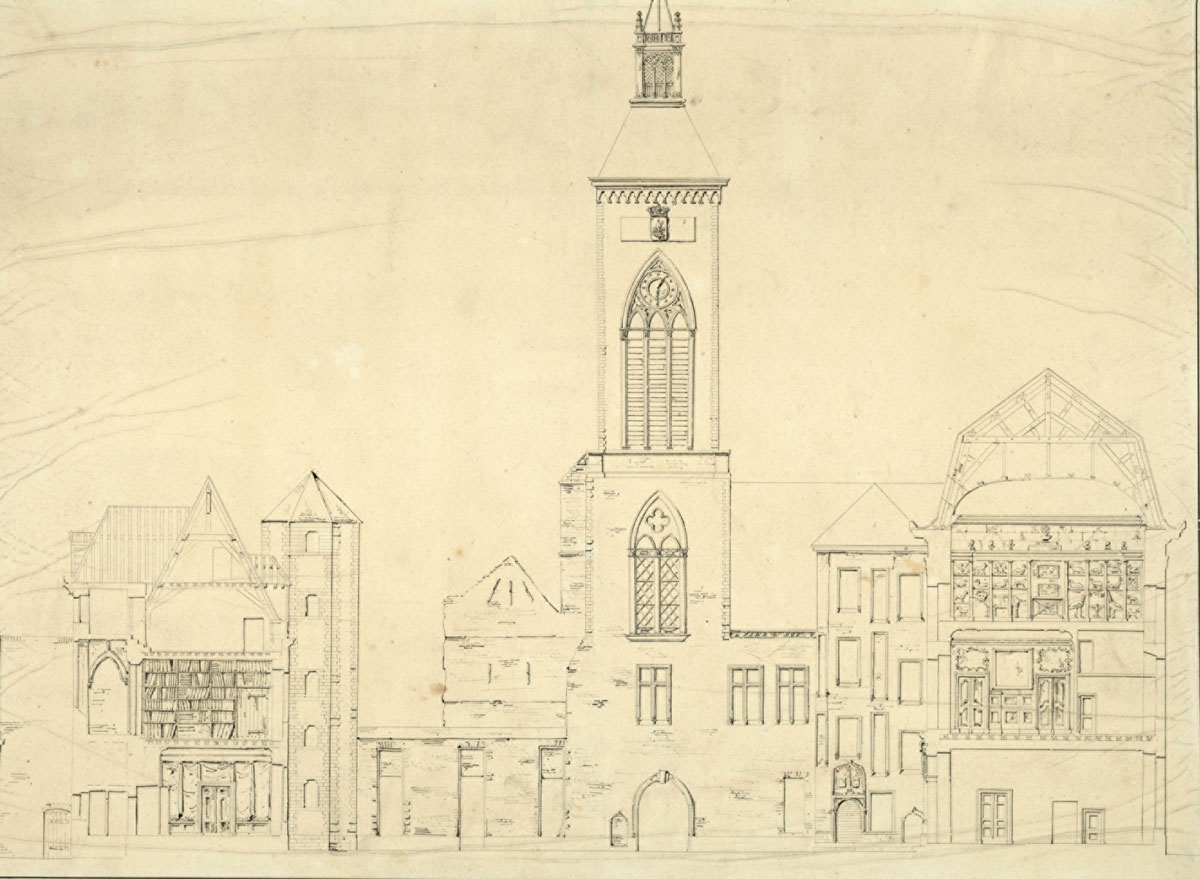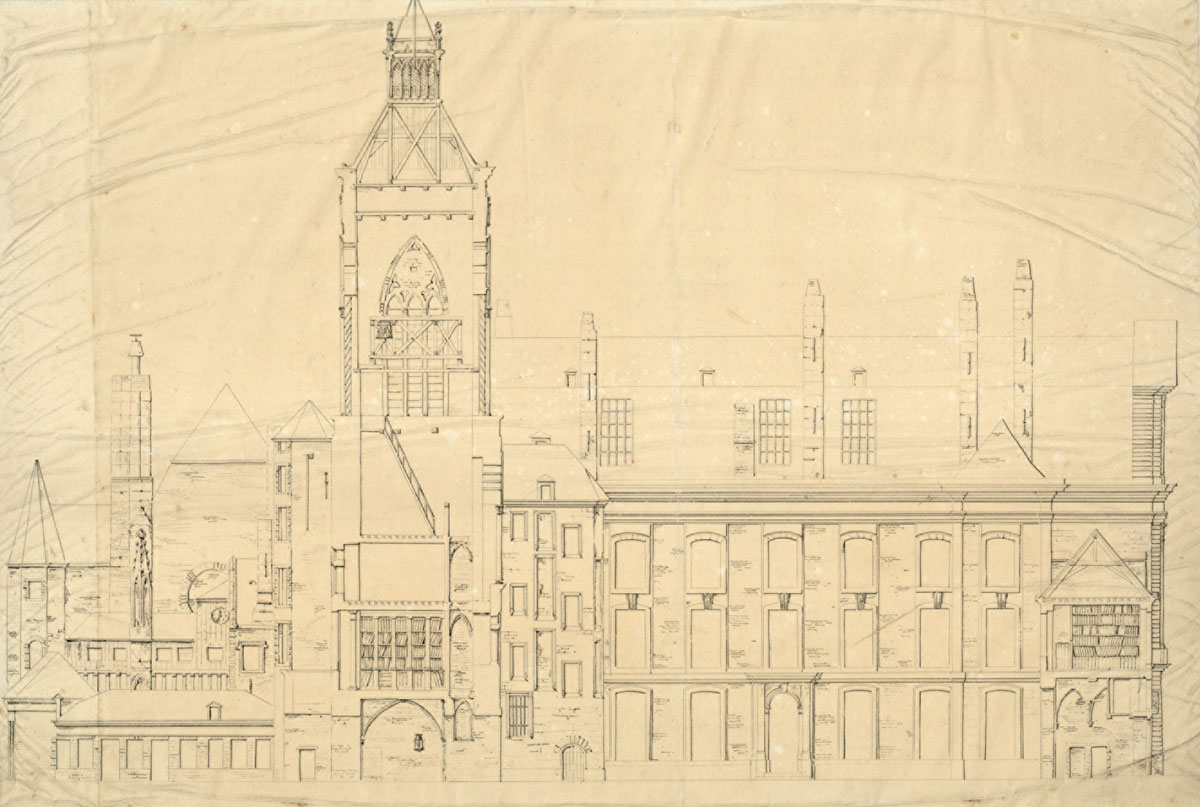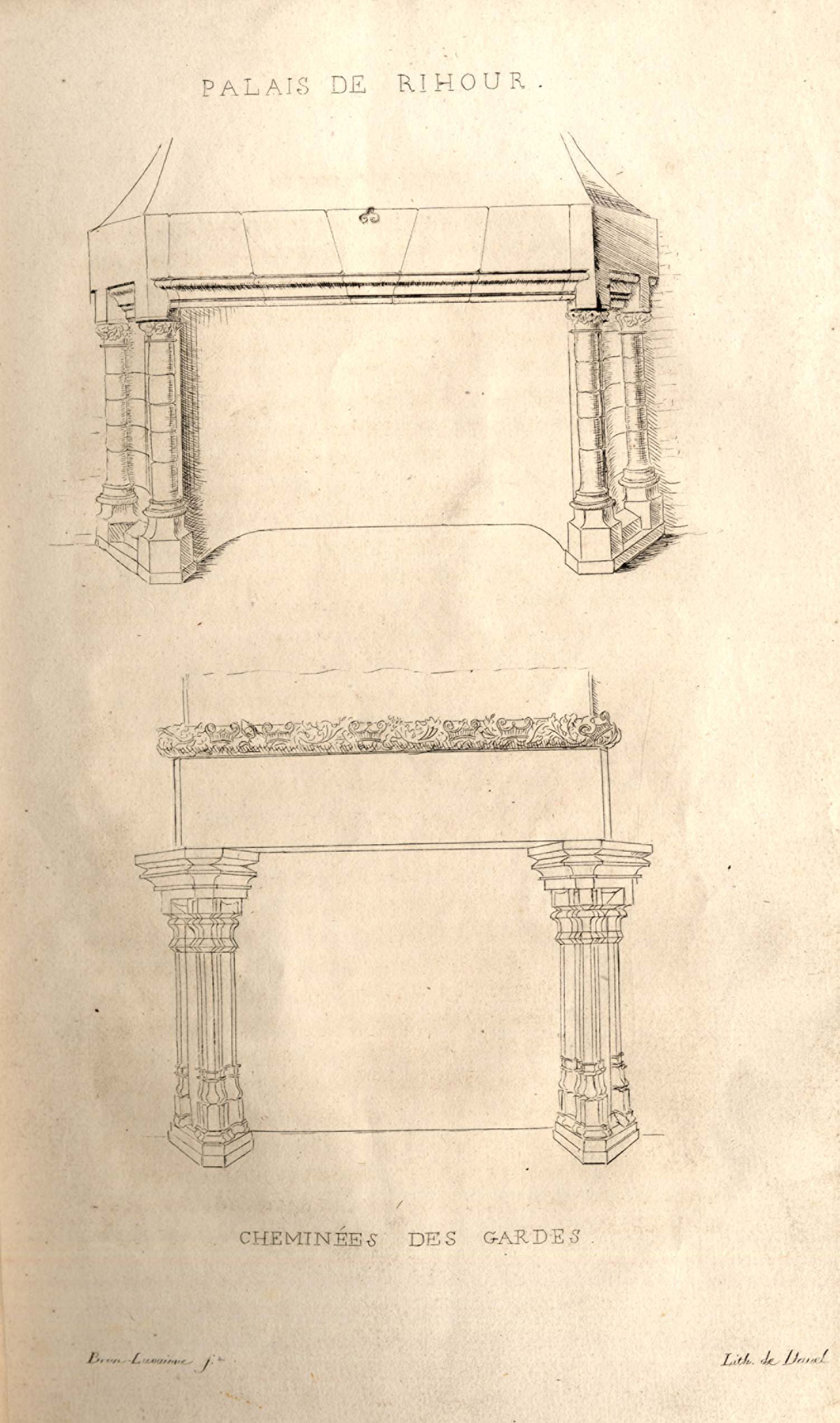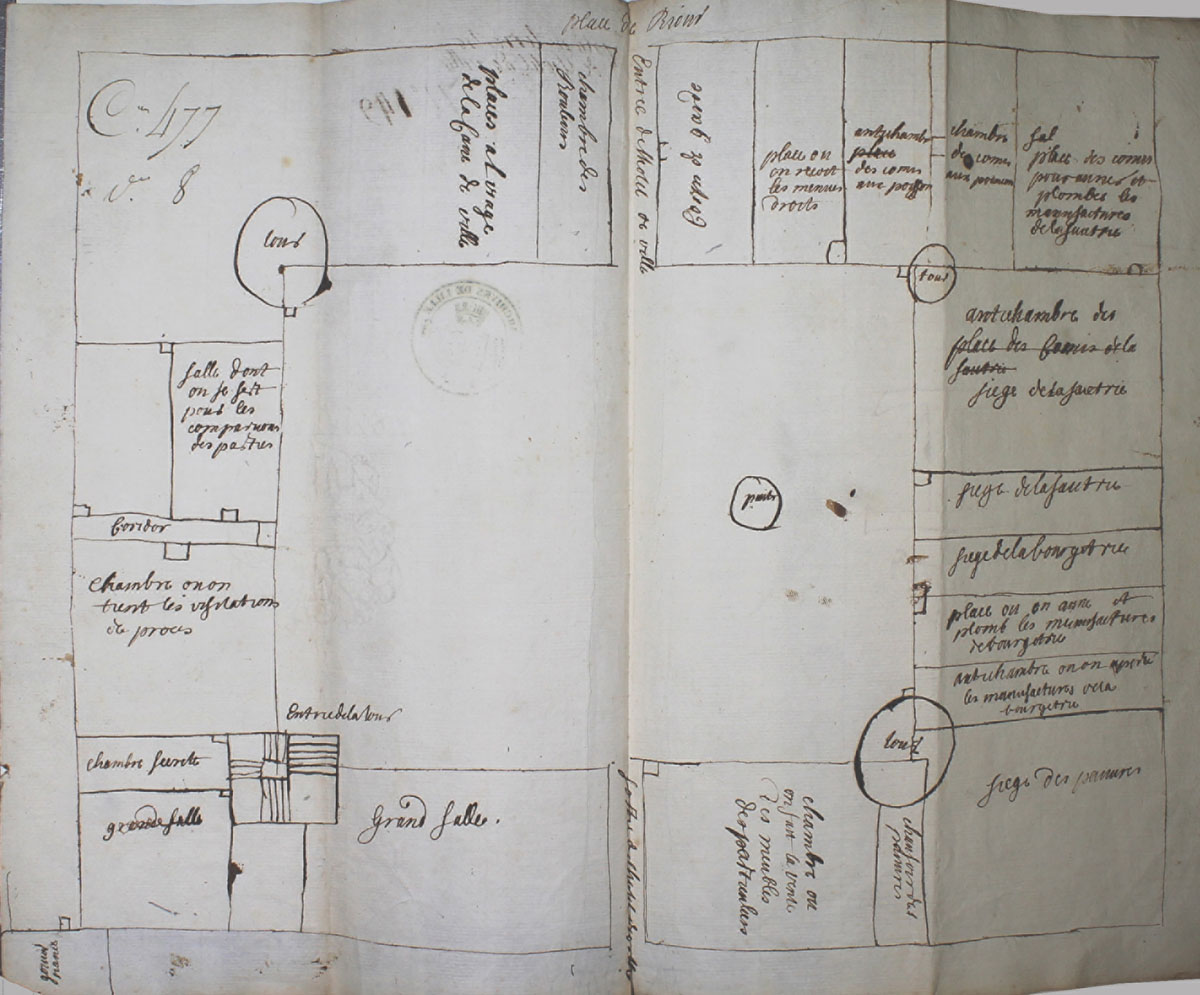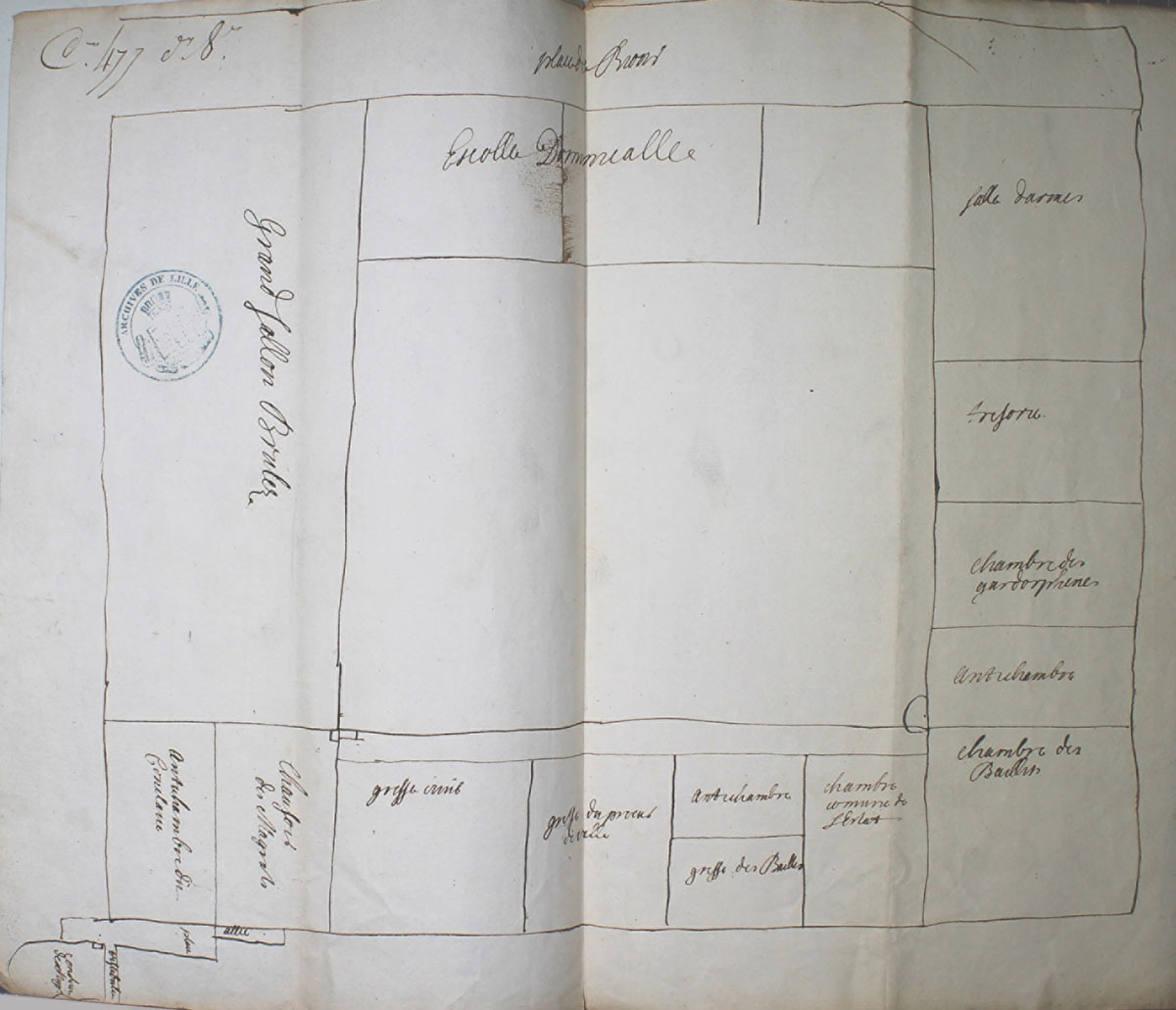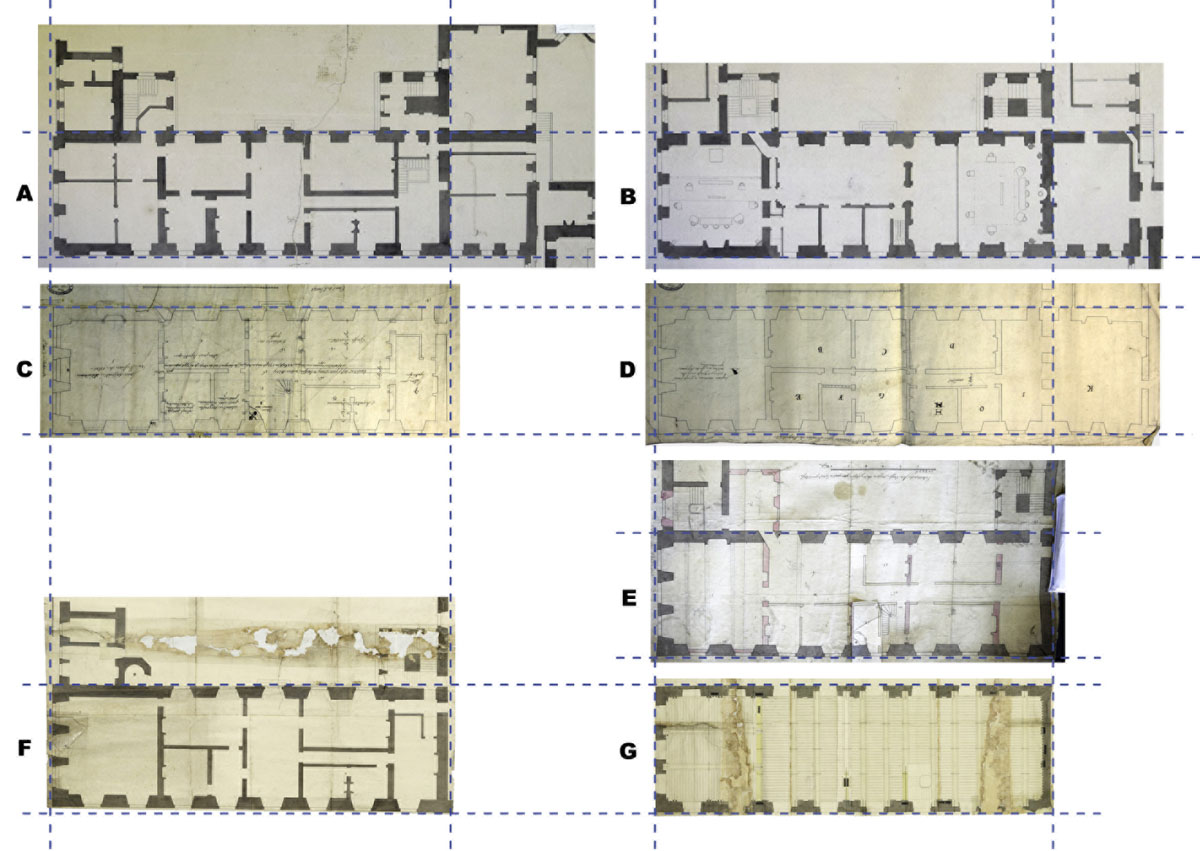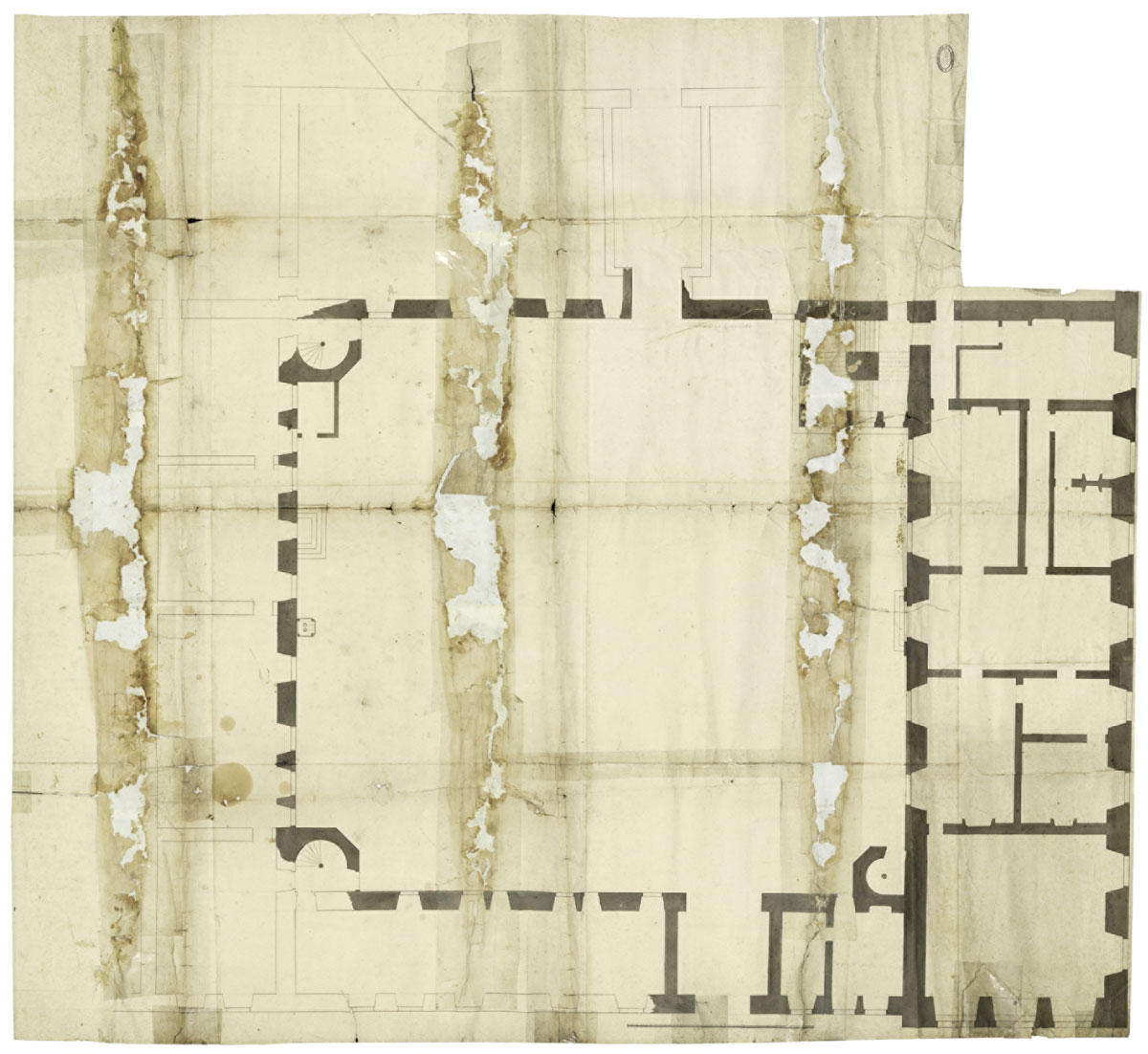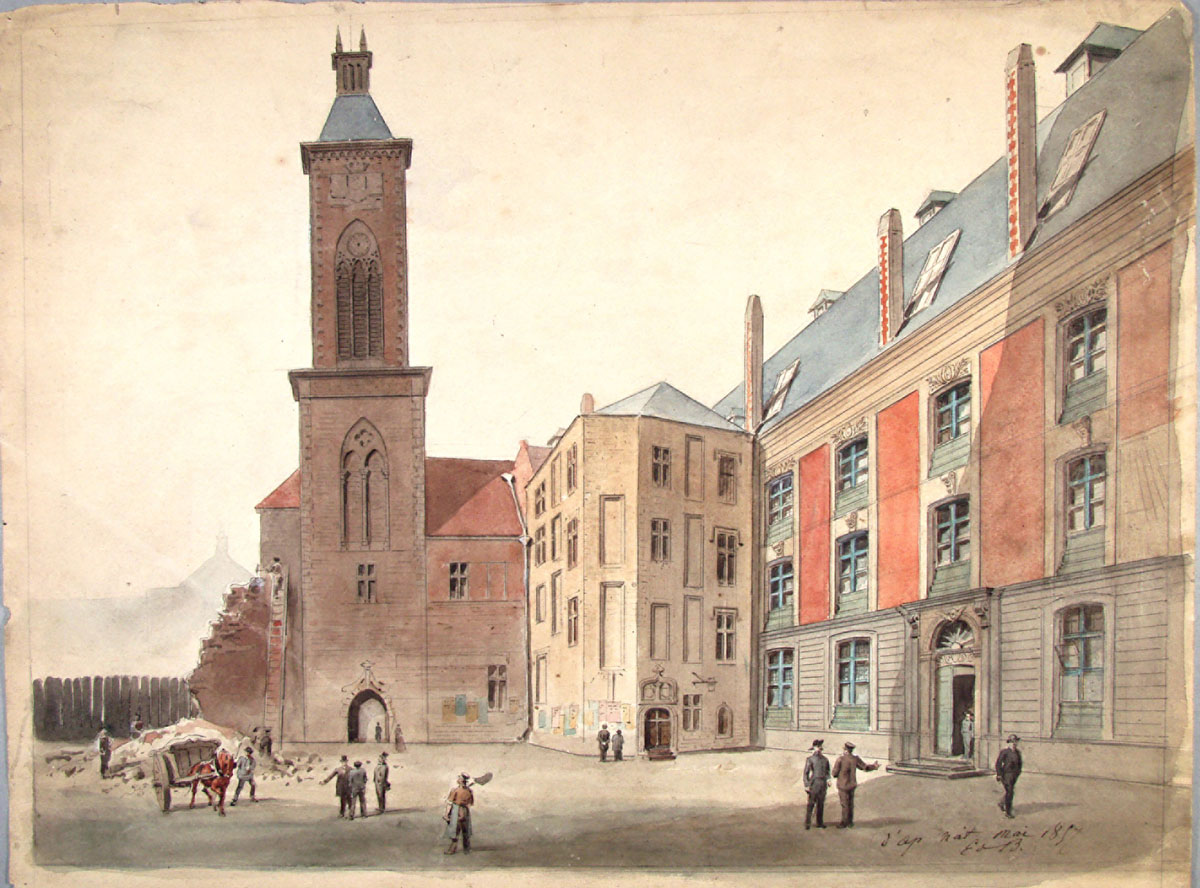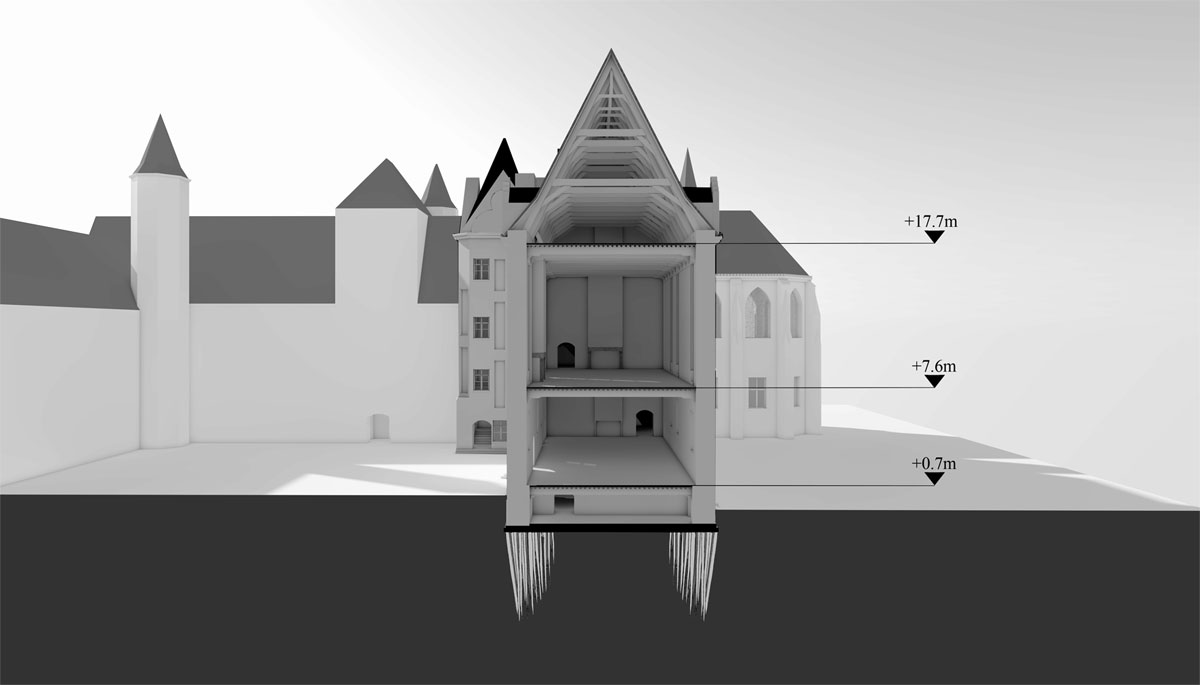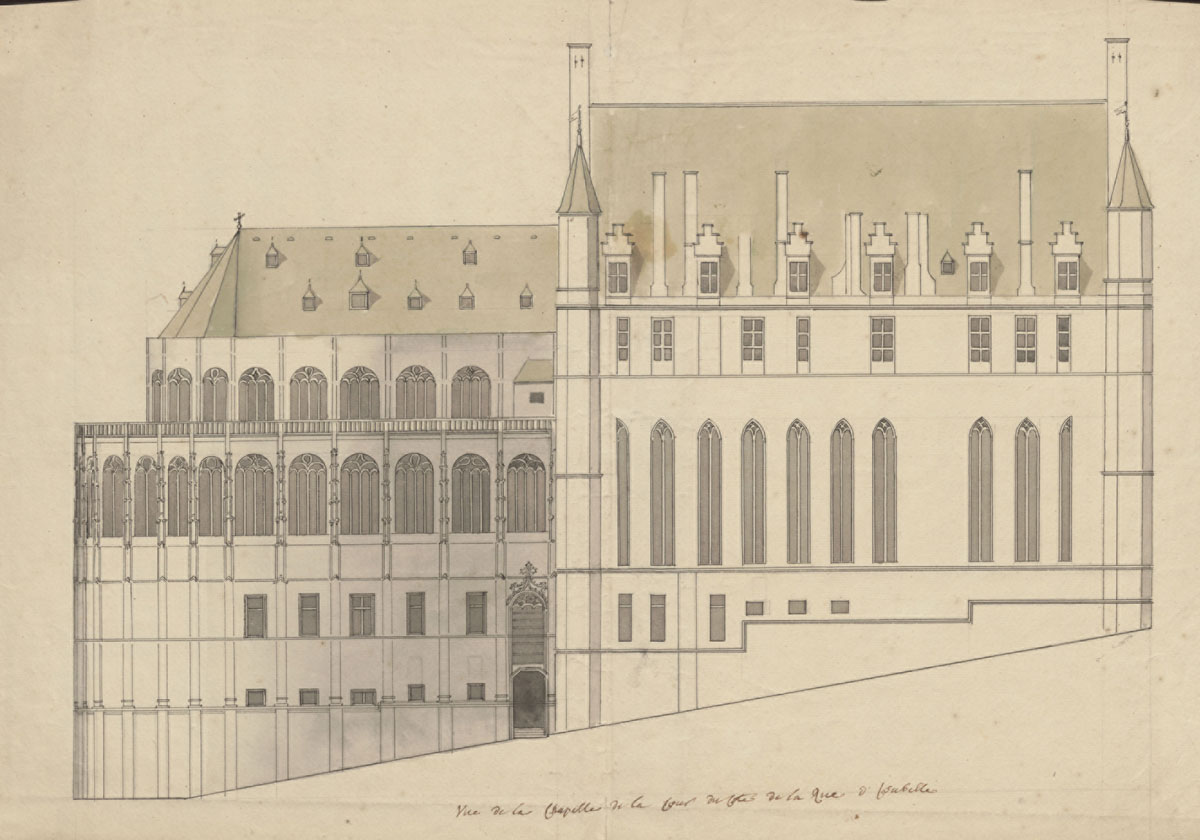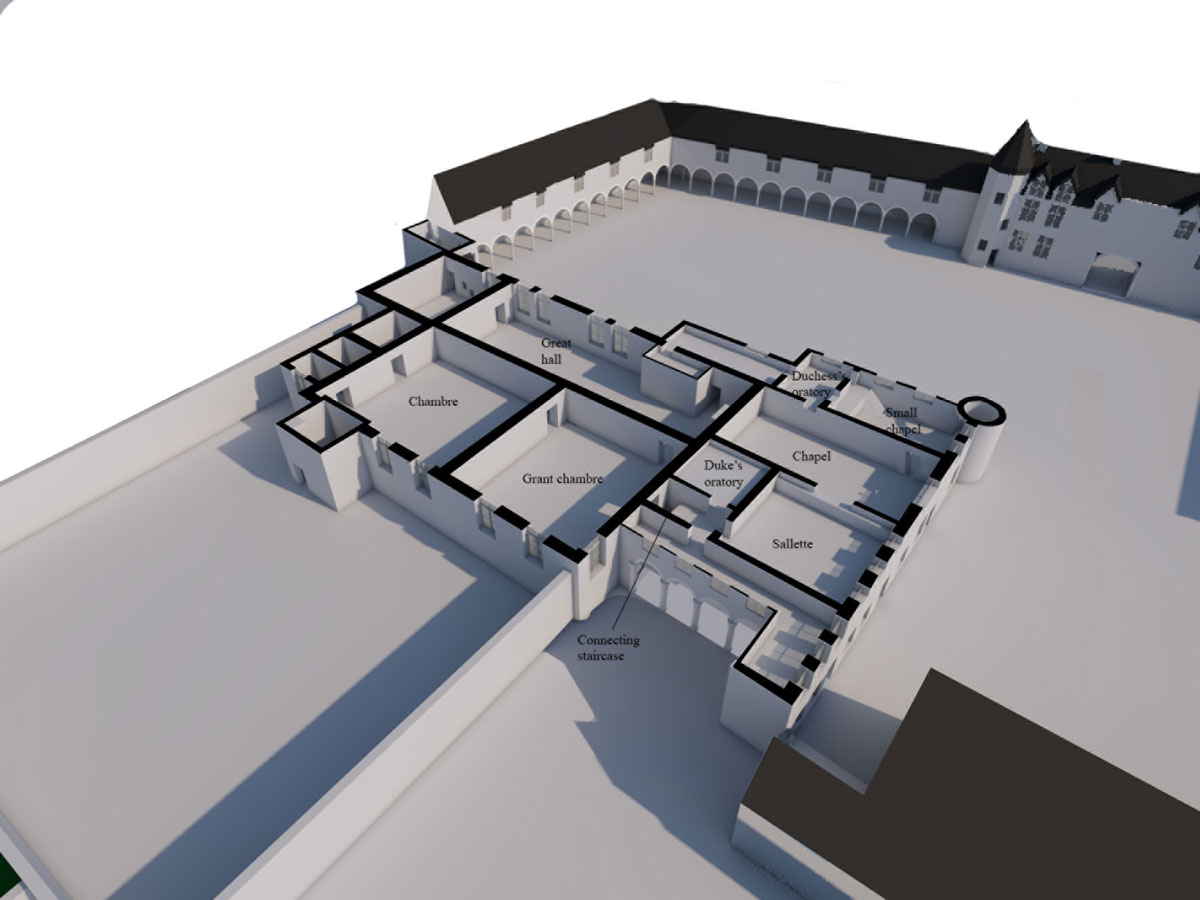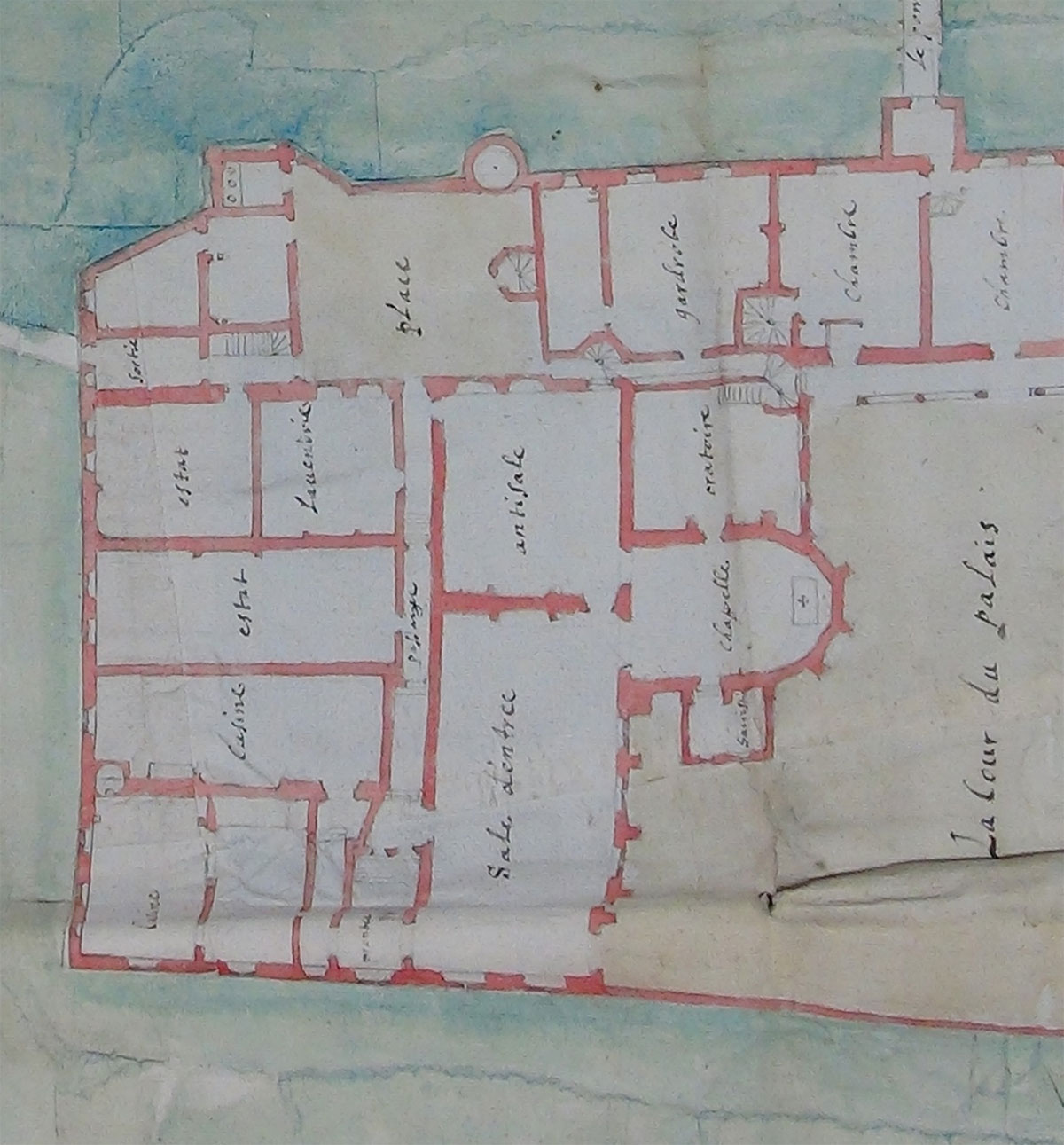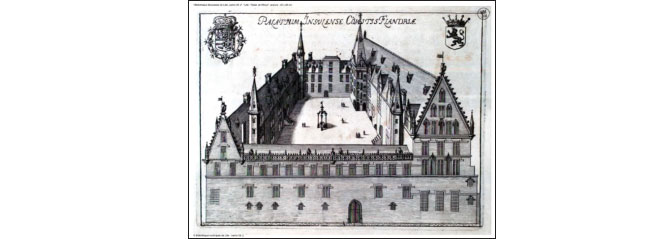Introduction
Today, the dukes of Burgundy are better remembered as patrons of the pictorial arts, literature, and music than as avid builders (Vaughan 2002; Belozerskaya 2002; Bradley et al. 2004; Keck, Marti, and Borchert 2009). While they cannot be compared to 16th-century ‘architect princes’ such as Henry VIII and Francis I, the ‘Grand Dukes of the West’, Philip the Good and Charles the Bold, had a keen interest in architecture, as new archival data shows. They commissioned several extraordinary residences that had a major impact on the development of palatial architecture in Northern Europe. This distorted image is largely due to the unfortunate loss of their main urban palaces in the Low Countries. Little remains of their residences in Bruges, Ghent, and Gorinchem (De Jonge 2000; Hurx 2017a; Hurx 2017b; Maekelberg and De Jonge 2018; Hurx 2022), while in Brussels only the excavated cellars of the great hall are fully preserved beneath the present Place Royale (De Jonge 1991; Dickstein-Bernard 2006; Dickstein-Bernard 2007; Heymans 2014). The only major part of a Burgundian palace still standing can be found in Lille, where the chapel and the large ceremonial stair tower of Palais Rihour have been preserved, albeit in a heavily mutilated and restored state (Figure 1).
Palais Rihour was built by the ‘Grand Duke of the West’ Philip the Good (1396–1467), who ruled over a large part of the Low Countries as the duke of Burgundy. It was intended to be his urban residence when he visited the city of Lille, one of the largest cities in the county of Flanders, and indeed in the whole of the Low Countries, and loyal to the duke during the Ghent Revolt of 1449 to 1453 (De Jonge 2000). Lille was of particular importance to Philip because it was the seat of his main financial institution, Lille Audit Office (Chambre des comptes), which had authority over Flanders and also oversaw expenditure in the whole of the Burgundian Low Countries.
Rihour was Philip’s most ambitious and influential architectural project. It set new standards for the display of princely magnificence. The four-wing complex had a well-arranged internal organisation (Figure 2): enclosing a spacious central, quadrangular courtyard, the south-west and south-east wings contained the chambers of the duke and the duchess; the north-west wing comprised the grant salle (great hall), which was used for large festivities, and the sallette (lesser hall), which served as a dining hall. Along the full length of the north-east wing, facing the Place Rihour, ran a long gallery that connected the great hall with the lodgings of the duchess. The chapel was attached to the western corner, outside the main quadrangle. In the corners of its courtyard stood distinctive staircase towers which led to the main reception rooms on the first floor. The surviving monumental square stair tower originally stood in the angle between the ducal lodgings and the great hall and was moved in 1857 to its current position in front of the chapel (Bruchet 1922: 231, 244). It introduced a new typology (Figure 3). Instead of a common spiral staircase, it had straight flights that were entirely vaulted and arranged around a square masonry core (Figure 4). These innovative architectural features, as well as the decorative brick-and-stone masonry, would influence the development of court architecture in Northern Europe and Spain (De Jonge 1999; Hurx 2021).
Top view of the reconstructed Palais Rihour. From Hurx (2021: 225).
The first comprehensive study on Philip the Good’s residence in Lille was Max Bruchet’s lengthy article ‘Notice sur la construction du Palais Rihour’ of 1922. Bruchet provides a detailed overview of Rihour’s construction based on thorough archival research; many of the documents he unearthed are included in an extensive appendix. Few other studies appeared in the 20th century, apart from Francis Salet’s article that briefly summarizes the palace’s history and describes its architectural design (Salet 1962; Chatelet and Gardelles 1970). Recently, more scholars have begun to pay attention to the palace. Krista De Jonge studied Rihour’s plan in comparison to those of the Burgundian residences in Bruges, Brussels, Ghent, and Lille (2000; 2009). Hervé Mouillebouche examined Lille in his study on the ducal residence in Dijon, comparing it with the distribution of spaces in Burgundian residences in the Low Countries (2019), while Ségolène Périneau investigated Rihour’s internal arrangement (2001) and Charlotte Bosmans proposed a three-dimensional reconstruction of the complex (2016). Irène Dietrich-Strobbe looked at the palace as a political device, arguing that the building was not just an expression of the duke’s authority and magnificence but also a reward for Lille’s loyalty in the wake of the Ghent Revolt (2015). Alain Salamagne studied the procurement of the different types of stone for the building and the role of the duke’s councillor, Michel de Chaugy, in the supervision of the construction of Rihour (2020; 2022). In Merlijn Hurx’s detailed analysis of Rihour’s design process and building history, he argues that the pioneering design was by no means the product of a single mastermind; rather, the planning of Rihour was a muddled process in which negotiations between the duke and his agents prompted redesigns that extended well into the building campaign (2021). In response to Hurx’s article, Salamagne sketched a different building history, arguing that work began a few years earlier (2022: 261–263).1
While Rihour’s general architectural features and spatial distribution have been studied, no attempt has been made to reconstruct its interior, because such an inquiry has been hampered by Rihour’s early destruction. Two disastrous 18th-century fires left two wings of the building in a ruined state: in 1700 the great hall burned down and in 1756 the ducal wing was severely damaged (Bruchet 1922: 241–42). At that time, Rihour no longer had a residential function; it had become superfluous, as no Habsburg prince resided in the Spanish Netherlands, and the complex had been sold to the city of Lille in 1664 to become its town hall.
In the second half of the 18th century, in response to the destruction caused by the fires, plans were made to modernise the entire complex, but due to a lack of funds, only the wing with the former great hall was rebuilt. However, the desire to build a modern town hall endured, and between 1847 and 1859, the architect Charles Benvignat replaced the medieval structure with a classicist design (Bruchet 1922: 242–44). This 19th-century building burned down in 1914, and the complex was demolished entirely in 1922, apart from the chapel and stair tower.
Rihour’s original exterior is known through a few extant visual sources. Three early depictions from the late 16th and early 17th century provide a bird’s-eye view of Rihour from the north-east, from the direction of Lille’s market square (Figures 5, 6), while a fourth bird’s-eye view shows the complex from the opposite side, with the chapel and ducal wing in front (Figure 7).2 These images provide a general impression of the building’s exterior, but the architectural details are unclear and sometimes contradictory.
Bird’s-eye view of Palais Rihour from the Place Rihour (the north-east) by Jacobus Harrewijn. It shows the façade with the main entrance and the gallery above, with its decorated parapet. On the left is the gable of the duchess’s wing, while the tall gable on the right is that of the great hall. Behind the gallery wing is the palace’s courtyard, and in the background is the ducal wing, the square staircase tower visible in the corner on the right. Engraving, early 17th-century. From Butkens (1726, 1: 24).
View of Palais Rihour from the Place Rihour in the north-east. 17th-century copy of a 16th-century manuscript, draughtsman unknown. Ms Leber, 5903, fol. 20v–21r, Bibliothèque Municipale, Rouen. Photo by Charlotte Bosmans.
View of Palais Rihour from the south-west, with chapel and ducal wing in front. Immediately to the right of the chapel is the gable of the sallette, which is depicted here as being made of brick with a limestone chimney, while in reality it was dressed with stone. 17th-century copy of a 16th-century manuscript, draughtsman unknown. Ms Leber, 5903, fol. 20v–21r, Bibliothèque Municipale, Rouen. Photo by Charlotte Bosmans.
Much less source material exists for Rihour’s interior. The earliest known comprehensive set of drawings of plans, elevations, and sections were made in 1829 by the city architect of Lille, Amé-François-Joseph Leplus (ADN, 56 FI 297). This survey, which has received little scholarly attention, shows the building after the residence was modified to serve as Lille’s town hall. More importantly, it is dated after the ducal wing and the great hall were destroyed by fire in the 18th century (Figures 8, 9, 10, 11, 12).
Based on archival material, some newly discovered and some that has not been the subject of much study, this article provides a meticulous analysis of Rihour’s most public spaces, the great hall and the sallette in the north-west wing. This wing was significantly wider and taller than the other three and was embellished more lavishly with stone ornamentation. Conspicuous parts, like the gabled dormers and the main gable facing Place Rihour, were entirely faced with stone. The great hall was situated on the first floor, above a raised basement and the ground floor level. Some of the 15th-century building specifications for the construction of the north-west wing are retained in a document in the Belgian National Archives at Brussels (AGR) (the document was first noted by Bautier and Sornay [2001: 70n6] but has never been analysed). The lengthy text provides detailed information on the wing’s original appearance. In addition, multiple previously unknown plans in the Archives départementales du Nord in Lille and the Archives municipales de Lille, plans made in the 18th century for the reconstruction and modernisation of the burnt wing, provide crucial information on the 15th-century situation.
Together, this source material, both textual as well as visual reference documents, allows for a detailed digital reconstruction in three dimensions of the north-west wing of the Palais Rihour, which can be considered a Critical Digital Model (CDM) as defined by Apollonio et al. (2021) for the virtual reconstruction of architectural artefacts. Since there are no shared standards in the scientific community for the digital reconstruction of lost architecture (Nevola et al. 2022), we documented our choices during the reconstruction process in a metafile (linked at the end of this article) to assure the traceability of these decisions (Vandevyvere et al. 2006; Boeykens et al. 2018). Because of the uncertainty about the identity of certain materials (for example, the material used for large surfaces as floors), we favored a ‘white model’ over a material-realistic reconstruction of the building to avoid the false impression of certainty about materials. The sources, especially the 15th-century building specifications, allow a high degree of geometric accuracy, especially with the inclusion of detailed measurements, such as those for the thickness of the walls and dimensions of the windows. The reconstruction was made using Graphisoft ArchiCAD 26, a Building Information Modeling (BIM) package which allows the visualisation and documentation of building projects. BIM presents a holistic and object-based approach, connecting two-dimensional plans and three-dimensional renderings with detailed documentation of the objects (walls, windows, etc.) that make up the reconstructed north-west wing of Palais Rihour (Boeykens et al. 2018).
This article will first examine the preserved building specifications, followed by a brief overview of the oldest surviving plans of the complex. After treating the primary source material, a step-by-step reconstruction of the 15th-century wing will be presented. The last section contextualises the reconstruction by comparing the design of this public wing with contemporary examples of Burgundian court architecture.
The Devise of the Great Hall
The 15th-century document preserved in Brussels provides a detailed description of the masonry of the north-west wing. It is written on three pieces of paper that are glued together, and it carries the note ‘la devise dela grant salle’. The word devis(e) is a generic term in medieval French for all types of plans for any undertaking, but in construction the word was commonly used for cost estimates and building specifications, as well as for architectural drawings (Hurx 2018: 242). In this case, the building specifications meticulously describe the dimensions and building materials of the masonry of the great hall and the sallette. The document was composed when work on the north-west wing was already underway, as the text mentions that the walls of the sallette on the first floor had been raised to a height of 4.2 metres.3 The walls of the ground floor below the great hall, however, only reached a height of six feet (1.8 metres). That means that the basement, which likely contained the kitchens, was largely finished. The function and arrangement of the ground floor is not mentioned in the document and remains unclear; it is probable, however, that the ground floor was subdivided into smaller rooms. Indeed, it seems unlikely that it was a single large space serving as a salle commune, because no such hall is mentioned in the preserved 15th- and early 16th-century inventories (Bruchet 1922, appendix 12: 272–80). In addition, a surviving 18th-century plan of the ground floor confirms that it contained multiple spaces, as will be discussed later (Figure 17).
The great hall on the first floor was the largest space of the entire complex. It extended from the sallette at the west all the way to the main gable on the Place Rihour; at that end, a portal led to the long gallery. While the sallette served as a dining hall, it also formed an important node in the circulation of the complex. It joined the great hall with the ducal wing and gave access to the vestibule of the chapel. The specifications show that directly above the great hall, in the huge attics, there were two levels of gallatas, used not for storage but for proper and comfortably heated lodgings.
The description of the work starts with the general dimensions of the perimeter walls of the great hall: it was to measure 146 feet long by 41 wide by 32 high (43.5 by 12.2 by 10.1 metres; the Lille foot measures 29.8 cm). On the long sides, the walls were four bricks thick, while the gable facing the Place Rihour was five bricks. After these general measurements, more detailed provisions follow, including the number and position of the mantelpieces in the great hall and its high limestone cross windows. The two mantelpieces on the long sides, to be made of Bray sandstone from Hainaut, were to be similar or better than the existing mantelpieces in the Palais Rihour. Fortunately, the drawings of two elaborate mantelpieces published by Élie Brun-Lavainne in his book on Rihour from 1835 provide us with an impression of how they may have looked (Figure 13). These two mantelpieces stood in the salle des archives of the town hall, which were originally the chambers of the duchess. They are likely to have resembled those of Bray sandstone in the great hall, because Brun-Lavainne mentions that in his time a similar mantelpiece was preserved in the ‘logement du concierge’ (Brun-Lavainne 1835: 22n2, 46). It appears that in 1835 this lodging was located on the ground floor directly below the former sallette (Brun-Lavainne 1835: 46).4 A third mantelpiece, installed at the hall’s end towards the sallette, was built of the precious grey-blue limestone from Écaussinnes, also in Hainaut, but the building specifications provide no details on its design.
Two 15th-century mantelpieces in the ‘salles des archives’ of the town hall, which were originally the chambers of the duchess. From Brun-Lavainne (1835).
The specifications show that the vast space was lit by only eleven cross windows: four on the long sides and three in the front gable. The windows were remarkably tall and narrow, measuring 24 to 26 feet high and 5.5 feet wide in clear dimensions (7.2 to 7.7 by 1.6 metres). Each had a mullion and three transoms, thus forming triple-barred crosses. The exterior wall was articulated by two moulded string courses of limestone that linked all the windows together: the lower course ran at the level of the windowsills and the upper course at the height of 22 feet (6.6 metres), between the upper transom and the lintel of the windows. The walls were crowned by an entablature (‘entaulement’) comprising a frieze and a continuous band of firesteels above, a firesteel being the duke’s heraldic badge. This band may have resembled the current, reconstructed entablature of the chapel. The specifications stipulated that the lower part of the entablature was to wrap around the entire wing, while the upper course was interrupted by gable dormers.
Following the description of the exterior decoration of the hall, the devise provides guidelines for the octagonal staircase tower in the interior angle of the long gallery and the great hall. The spiral staircase, which gave access to the gallery on the first floor, had the considerable interior diameter of eleven feet (3.3 metres), which indicates that it was not merely a service staircase. The steps and the windows had to be made of limestone, but important design decisions, such as the number of windows, were left to the builder’s discretion.
The specifications also addressed the masonry for the unfinished sallette, which was a spacious room measuring 41 by 31 feet (12.2 by 9.2 metres). To create space for an additional storey above, its ceiling was 12 feet lower (3.6 metres) than the great hall. The actual function of this room on the second floor is unknown, but it could be reached by the spiral staircase in a corner of the sallette. This octagonal, wall-mounted tower projected from the outside wall and was tucked in between the sallette and the chapel; the instructions mention that the bricks should be well-bonded with the chapel’s walls. It was also not a service stair, as indicated by its similar span of 3.3 metres. With a height of 60 feet (17.9 metres) above the floor level of the first storey, the tower protruded almost eight meters above the eaves of the roof; in addition to giving access to the second floor, it was also connected with the attics above the sallette as well as with those of the chapel, above the vaults.
The room on the second storey and that in the attic directly above were heated and had mantelpieces against the party wall between the wing of the great hall and the duke’s lodgings. The attics above the great hall were similarly heated by fireplaces placed against the wall dividing the hall from the sallette, which extended all the way up to the roof ridge. Directly above the hall’s mantelpiece of blue limestone from Écaussinnes were thus two additional mantelpieces, one above the other, serving the lower and upper gallatas respectively. With a thickness of six bricks, this dividing wall was considerably heavier than all the other walls of the wing, probably to allow sufficient space for the flues of the fireplaces. The attics were therefore comfortable living spaces; the lower level in particular was well lit by the large cross windows in the front and back gables and by the gabled dormers on the long sides. The exterior of the dormer gables stressed the importance of this storey by being entirely dressed with limestone and decorated ‘as appropriate’, as the specifications make clear.
The existing bird’s-eye views (Figures 5, 6) confirm that the wing’s front gable, facing Place Rihour, was richly decorated and entirely clad with stone. The specifications do not mention this part of the building, so it is likely that a separate document was drawn up for it. Instead, the less conspicuous gable on the opposite side (Figure 7), which overlooked the gardens, is included in the devise of the great hall. It was sparsely decorated and made of brick; only the sloping edges of the roof were adorned with so-called French pinnacles (‘cappes franchoises’) of limestone. This term likely refers to the fleur-de-lis cresting which also adorned the front gable, as can be seen in the 17th-century bird’s-eye view (Figure 5).
The specifications provide important details about the connections between the spaces. For the great hall, two limestone portals of six feet wide and nine feet tall were made, one providing access to the long gallery and the other to the sallette. The sallette was an important nexus linking the great hall both to a vestibule, leading to the chapel, and to the ducal wing.5
Date and Function of the Devise
The devise of the great hall lacks a date, but it is highly likely that the document was prepared for a public tender of the masonry in January 1465 (Hurx 2021: 243–44). Construction on Rihour had begun around 1459, but by 1465 only the ducal wing and the larger part of the chapel were finished. After repeated admonishments by the duke to make haste with the construction, the Lille Audit Office (Chambre des comptes, CC), which was charged in 1462 with the construction’s supervision, proposed to tender the masonry ‘in gross’, meaning as a single contract, because it believed that such a contract would significantly accelerate the building pace.6 A letter, dated 8 January 1465, was sent by the Audit Office to the ducal counsellor Michel de Chaugy, who supervised multiple construction works for Philip the Good (Salamagne 2022), in which capacity he also acted at Rihour as the duke’s aesthetical advisor and go-between with the Audit Office. The letter explains that the Audit Office had made three devises for the masonry of Rihour, of which copies were sent to Brussels for inspection (ADN, CC, B 17699). The auditors hoped that de Chaugy would soon announce the public tender in Brussels and promised to send copies with invitations for the tender to the cities of Tournai, Douai, Béthune, Valenciennes, and other places in the Low Countries (‘par deça’). It was expected that by contracting out, the work would be done faster than in previous years. A letter from the Audit Office written four days later (12 January 1465) specifies the nature of the three devises: The first document concerned the grant salle and sallette, the second the remaining masonry of the chapel and the third the monumental square stair tower.7 The auditors hoped to tender the masonry of the upcoming year before the start of the construction season in spring. On the 28th of January, the auditors wrote to de Chaugy that the three devises and the invitations to the tender (‘criees’) were ready but that the designated date for the first meeting of the bidding procedure of 9 February was too early, because the tender was to be announced in a number of towns. Therefore, they proposed postponing the tender by two weeks: The bidding was to be organised in two rounds of ‘candle auctions’, in which contractors could make their bid during the burning time of a candle, with the first round on 23 February and the second two days later (ADN, CC, B 17699).
Meanwhile, the duke inspected the devises and made clear to the Lille Audit Office that he refused to tender the masonry because he feared it would negatively affect the quality of the work. He expressly instructed the work to be done by day labourers, in a letter dated 25 January 1465 (ADN, CC, B 17699). The Audit Office, however, did not simply comply with the duke’s order. To persuade the duke, it composed a memorandum which was intended to alleviate his concerns about contracting out (Hurx 2021: 243–44; Bruchet 1922: 255–59, appendix). Enumerating all its benefits, the document reads almost like a present-day consultancy report on outsourcing. The auditors reassured the duke that no disadvantages were to be expected, as contracting out would speed up the pace of building and diminish the costs without affecting the quality of the work. Early in February 1465, the Lille audit master Pierre le Carbonnier travelled to Brussels for an audience with the duke and his great council to convince them of the advantages of tendering the work (ADN, CC, B 17699). The outcome of this meeting is not documented, but Le Carbonnier wrote on 23 February to his fellows in Lille that he believed that the duke’s resistance to tendering the masonry was diminishing. While we do not know for certain, the speed with which the great hall was erected — a great part of the walls was finished in less than ten months — suggests that the auditors won the argument (Hurx 2021: 244).
It seems curious that detailed specifications of the great hall were not drawn up until the wing’s construction was well under way. This late moment for specifications in the construction process was possibly prompted by the proposed change to the construction’s organisation: tendering the masonry made it necessary to explicitly describe the required work. However, it also fits the gradualist design approach of Rihour, which left many aspects of the design open until the point when the process of construction neared the actual fabrication of those aspects. While there was likely a general plan that defined the building’s spatio-structural traits at the start of the project, major design issues were only decided as construction advanced. At the beginning of a new phase or at the start of a new construction season, the relevant design was worked out in detail, and in several cases major changes were proposed even after the work had begun (Hurx 2021).
The devise of the great hall describes the project in great detail, but its exact function is unknown, because its practical use as a guideline for the contractor seems questionable. Where 15th- and early 16th-century building specifications in the Low Countries often present the project in the order in which the building was to be erected, the document for Rihour lacks such a clear structure (Hurx 2018: 303–304). In addition, it lacks important information on construction procedures, and no quantities are mentioned. The document does, however, include a remark on the progress of the work: the walls should reach the level of the cornice in the coming construction season. Even though clear measurements are provided for the spaces, wall thicknesses, portals, and windows, no mention is made of the exact position of windows, mantelpieces, and portals. In the 15th century, many such details were commonly left to the builders’ discretion, but usually additional information was also provided through accompanying drawings. Yet the document lacks any references to drawings or the stonecutters’ templates that were necessary for cutting the stone elements. Indeed, it is unclear whether it concerns only the labour of bricklaying and the assemblage of the limestone blocks or the supply of the building materials as well. Although the specifications were likely drafted in preparation for the 1465 tender, it is uncertain whether this is actually the final document that accompanied the invitation to the tender. Taking into account its discrepancies, the surviving document could very well have been a first draft used mainly to communicate the nature of the work between the auditors in Lille and the duke’s counsellors in Brussels.
Designs for the Re-erection of the Great Hall after the 1700 Fire
The written specifications lack important information for the three-dimensional reconstruction of the 15th-century wing, despite their level of detail. The document is complemented, however, by a set of drawings of Rihour made before its destruction in the mid-19th century. Unfortunately, no plans remain of the situation before the fire of 1700. The most comprehensive set of drawings are those made by Leplus in 1829, mentioned above. He provides plans at all levels, including the foundations, as well as an elevation of the façade facing Place Rihour, elevations of all four façades of the courtyard, along with their corresponding cross-sections, and an elevation of the gate towards the former gardens (Figures 89101112). Even though these were made after the rebuilding of the north-west wing, they still show essential details of its original appearance. It seems likely that the thick, load-bearing 15th-century brick walls largely withstood the fire and that they were reused for the new 18th-century wing. Several written sources published by Bruchet show that the damage mainly concerned the hall itself, and although the ground floor is also reported to have suffered from the fire, it could be repaired fairly quickly. The basement was spared because it was protected by vaults.8 Two schematic plans of Rihour from 1720 survive in the municipal archives in Lille (Figures 14, 15). These plans were made at the time when discussions arose as to whether to rebuild the wing or to replace the old palace by an entirely new building (AML, AG, 477/8).
These two plans depict the ground and first floors of the building. The ground floor plan reveals that the rooms below the great hall were already in use after some repairs, because their function is specified, while the plan of the first floor carries a caption that indicates that the great hall had burned down (‘Grand sallon brulez’). Moreover, the former sallette was not entirely destroyed: On the plan, this space is divided by a thin partition wall into two separate rooms, one of which functioned as a heated reception room for the magistrature (‘Chauforts des Magrats’) and the other as an antichambre of the ‘Conclave’ meeting hall, which was located in the former chapel. Although damages were reported in 1700, it seems likely that the sallette did not suffer as much as the great hall did, probably because it was protected from the fire by the six-foot-thick wall that separated it from the great hall; since this wall rose up to the roof ridge, it must effectively have acted as a firewall.9
Though multiple proposals for an entirely new building were made in the 1720s, it was finally decided in 1729 to rebuild the damaged wing only (Olivier-Valengin 2000: 345–46). Several plans remain for its reconstruction in the Archives départementales du Nord, displayed in Figure 16 at the same scale for the sake of comparison.
Multiple 18th- and 19th-century plans of the north-west wing of Palais Rihour, ground and first floors, presented in a table, all in the same scale and laid out to demonstrate different plans for same locations (some plans are presented upside-down to align with the orientation of the rest). First column contains ground-floor plans; second column contains first-floor plans. Row A-B by Amé-François-Joseph Leplus; row C–D by Charles-François Verdière; row E by an unknown draughstman, ca 1730; row F–G by an unknown draughtsman, 1700–1720.
Ground floor
A) Amé-François-Joseph Leplus, detail of Figure 9, 1829. ADN, 56 FI 297.
C) Charles-François Verdière, around 1730. ADN, 56 FI 299A.
F) Unknown draughtsman, partial plan of Palais Rihour, detail of Figure 17, between 1700 and 1720. ADN, 56 FI 299F.
First floor
B) Amé-François-Joseph Leplus, detail of Figure 10, 1829. ADN, 56 FI 297.
D) Charles-François Verdière, Projet du M. Verdiere pour messieurs du Magistra., around 1730. ADN, 56 FI 299A.
E) Unknown draughtsman, around 1730. ADN, 56 FI 2046.
G) Unknown draughtsman, plan showing the crossbeams of the great hall, between 1700 and 1720. ADN, 56 FI 299F.
Unknown draughtsman, partial plan of Palais Rihour at ground floor level showing the spaces below the great hall (right), the gallery (bottom), the duchess’s wing (left), and the ducal wing (top). The drawing depicts the octagonal staircase turret at the angle of the great hall and the gallery still intact, and therefore it must have been made between 1700 and 1720. ADN, 56 FI 299F. Photo by Merlijn Hurx.
The 18th-century designs shown in Figure 16 accompany plans of the wing at the ground (A) and first floor (B) by Leplus, which were made after the great hall was rebuilt. All the 18th-century designs are undated, but in Figure 16, a ground plan (F) and the accompanying drawing of the beams supporting the great hall (G) are likely the oldest surviving plans of Rihour (ADN, 56 FI 299F). An important clue to the early date is the depiction of the 15th-century octagonal staircase tower in the corner between the great hall and the long gallery (on the left), which was replaced by a grand stairway in the 18th century. The plan is thus likely to have been made in preparation for the reconstruction of the hall, between 1700 and 1720. It shows the multiple spaces below the great hall. The thickness of the exterior walls indicates that the walls mostly date from the 15th century, although they may have been modified as there are more window openings than mentioned in the building specifications of 1465. The shape of the depicted mantelpieces suggests that some of the interior walls also date from the 15th century.
The second-oldest pair of surviving plans probably dates from around 1729, when preparations for the rebuilding of the great hall began (C and D) (ADN, 56 FI 299A). The plan of the first floor carries the caption ‘Project du M. Verdiere pour Messieurs du Magistrat’, and it seems likely that the two were made by Charles-François Verdière (d. 1742), who was clerc des ouvrages of the city of Lille (‘Verdiere’ 1913: 89). The interior arrangement of the ground-floor plan C is similar that of plan F, while the first-floor plan D is subdivided into multiple rooms. Openings were to be made in the wall between the old sallette, indicated on plan D by the letter K, and the former great hall. However, Leplus’s 1829 survey shows that these openings were never realised. The next drawing of a first-floor plan (E) was possibly made around the same time. It shows an alternative plan for the interior arrangement (ADN, 50 FI 2046). All newly constructed walls are indicated by a lighter shading. The drawing shows two stairs, one halfway down the wing, and a more monumental staircase in the gallery wing on the left.
After an analysis of these plans and elevation, it becomes clear that even though the wing looks entirely 18th century (Figure 18), a substantial part of the 15th-century walls was reused. A comparison of the oldest plan with Leplus’ drawings shows that at the ground floor even the interior arrangement remained largely unaltered in the 18th century; only some thin partition walls, likely made of wood, were added. In contrast with this, the first floor was entirely rebuilt and subdivided into multiple rooms.
Edouard Boldoduc, view of Rihour during its demolition in 1857. From left to right are the 19th-century belfry, the 15th-century stair tower, and the 18th-century reconstructed wing, 1857. ML 1462, Musée de l’Hospice Comtesse, Lille. Photo by Frédéric Legoy — Musée de l’Hospice Comtesse/Ville de Lille.
The Model
For the digital reconstruction of the 15th-century great hall of Palais Rihour (Figures 19, 20), we began with the set of plans, elevations, and sections made by Leplus. The situation they show postdates the original construction period by almost four centuries. The original four-winged layout of the Burgundian residence is still clearly recognizable, even after two devastating fires. The plans do not indicate a scale, but after scaling the great hall to the dimensions mentioned in the devise (43.5 by 12.2 metres) and checking the dimensions of the building parts still standing — the chapel and the stair tower — we can conclude that the plans were actually made to scale. Superimposing the scans of scaled plans of the different floors thus served as the starting point for the model, while Leplus’ elevations supplied the height measurements, together making it possible to reconstruct the volume of each wing. This allowed us to take into account the connections with the adjoining wings and to provide the necessary context for the reconstruction of the great hall and the adjoining sallette. The ground floor of the great hall wing was subdivided into smaller rooms; they could be accessed directly from the inner courtyard by a door preceded by four steps (Figure 9 and Figure 18). Several earlier visual sources confirm the presence of these steps and thus of a difference in level (Figures 5, 6), which allowed for apertures at the courtyard level, to illuminate and ventilate the semi-interred kitchen floor beneath.
The plan de fondations included in the set of drawings made by Leplus (Figure 8) does indeed show a basement level divided by thick brick walls, which probably served as transverse anchors, tying the two longitudinal façade walls of the wing together. The north-western or outer façade contained several window openings and even two doors leading directly from the adjoining street to the kitchens of the palace; the latter might have been used to bring food and supplies into the semi-underground spaces. The opposite façade, facing the inner courtyard, however, does not actually show openings. This might indicate that the inner courtyard was raised above the level of the surroundings. Given that the main, or quadrangular, staircase only began at the level of the courtyard, the octagonal staircase tower in the corner between the gallery wing and the great hall must in all probability have been used to bring up food from the kitchens to the great hall on the first floor. This actually lengthened the route the food service had to follow to reach the sallette. Another door gave access to this staircase tower from the inner courtyard.
The thick transversal walls in the basement ensured the stability of the construction. We assume that wooden crossbeams carried the floor above (at ground level). The square basement room towards the main gable, however, must have been vaulted, which is also confirmed by a mention of vaults ‘below the great hall’ after the fire in 1720 (Bruchet 1922: 294). The column placed at its centre in Leplus’s basement plan suggests a configuration of four rib vaults of equal size (Figure 8), likely similar to those in the still extant basement below the chapel (Mouillebouche 2019: 565; Clabaut 2000: 177).
The 18th-century plan showing the structure of the crossbeams that carry the floor of the lower attics above the great hall (Figure 16, plan G), presents twelve beams that connect the two longitudinal facades, while two perpendicular beams span the final stretch of the great hall towards the main gable (ADN, 56 FI 299F). These beams are not placed at equal distances, but rather on either side of the windows. Edge beams traditionally placed against the walls, or even half inserted into them, are not shown on this plan, but must have been present since they are needed to support the secondary beams in the end bays. There was probably one towards the dividing wall with the sallette and one on each side of the perpendicular set of beams towards the gable. In total, 17 large beams (14 crossbeams and 3 edge beams) supported the floor of the great hall. This corresponds with an account from 1463 which mentions that 17 huge crossbeams (‘sommiers’) 45 feet (13.4 metres) long and 22 thumbs (600 mm) thick were ordered from the Forêt de Mormal, some 65 kilometres southeast from Lille (ADN, CC, 4 October 1463, B 17695; Bruchet 1922: 237).
The secondary beams of our reconstruction are also dimensioned and placed according to the 18th-century plan, which shows a very dense beam structure spaced apart by a centre distance of 30 cm (approximately one foot) between them. The same plan also gives an indication of the different flue ducts, which were integrated into the thickness of the wall according to the 15th-century devise. Some of these rose up from the fireplaces in the kitchens underneath, but the others evidently corresponded with mantelpieces in the great hall and above. A rather large mantelpiece stood against the massive wall that separated the great hall from the adjoining sallette. Since the underlying kitchens also had large fireplaces, three flue ducts are visible on the plan in this location, probably two coming from the kitchens and one from the fireplace on the ground floor. According to the devise, two other fireplaces were situated along the longitudinal wall towards the inner courtyard. The plan indeed shows several ducts (shown as black quadrangles) in this wall, even one at the location of the big beam (shown in yellow) that marked the change of the load-bearing direction towards the main gable. This can be explained by the location of a fireplace against the transversal wall on the ground floor of this volume. The duct would have to bend towards the adjacent longitudinal wall so as not to show in the open space on the first floor, since the transversal wall is not continued on this level but replaced by a massive wooden beam. The second mantelpiece of the great hall could thus be located against the wall towards the long gallery, where another flue duct is indicated in black. The location of the third large chimney of the great hall cannot be inferred from this plan, but it was likely located above the door opening from the inner courtyard. Different visual sources indeed indicate a massive chimney above this entrance (Figures 567). The drawings of Brun-Lavainne serve as a basis for the reconstruction of the chimneypieces, a plausible hypothesis since the devise states that the chimney profiles must be the same as those already supplied (Figure 13). We made a simplified model based on one of the mantelpieces that stood in the salle des archives, the former rooms of the duchess. The two supports of the chimney have a rectangular base with chamfered corners from which three profiled columns emerge. These columns support a simple mantel spanning the 3.2 m width of the hearth. We used the same simplified model for all three of the chimneypieces in the great hall, since there is no additional source material for the blue limestone mantelpiece near the sallette, which was probably even more monumental and ornate.
The 11 windows of the great hall were modelled on the basis of the devise and the visual sources and in analogy with other contemporary examples. The devise is the most important text; with its high level of accuracy and reliability, it presents a contemporary document comparable to modern building specifications. It provides detailed information on both the dimensions as well as the material of the great hall, such as for the brick walls and the windows. We can therefore be accurate about the structural elements that make up the great hall, especially since later visual sources confirm the layout of the great hall. For example, from later floorplans it becomes clear that the transversal façade towards the east was thicker than the longitudinal façades, which was indeed the case according to the devise, which says that it was five bricks thick (as compared to a thickness of four bricks for the other exterior walls).
According to the devise, the 7.5-metre-high cross windows were made entirely of stone. They had one vertical mullion and three horizontal transoms, forming a triple-barred cross. The lights above the transoms were filled in with fixed stained-glass panels, while the lowest and tallest windows likely had wooden window frames set within the stone surrounds. The lowest parts of these windows likely had wooden shutters without glass, which could be opened to let in air. On the inside, each window had a window seat and steps leading up to it, similar to the still extant windows in the square stair tower (Figure 4). We determined the location of the windows on the basis of the 18th-century floor plans in combination with the 16th and 17th depictions of Rihour.
The decoration of the exterior wall, of two moulded string courses of limestone and a cornice, is chiefly based on the devise, because the visual sources are ambiguous and lack accuracy. For instance, the 17th-century engraving by Harrewijn does not show any decoration on the long sides, while the 16th-century Rouen drawings depict a string course running below the windowsills (Figures 567). Only for the front gable of the great hall is more detail provided, in the two bird’s-eye views showing the residence as it faced Place Rihour (Figures 5, 6).
The great hall was accessible from the main staircase in the square tower in the corner of the courtyard. This tower, or at least its entrance level, served as a hub between the two adjacent wings and the courtyard. Three exterior doors connected the staircase directly with the inner courtyard. Two interior doors gave access to both the ground floor of the ducal wing and the spaces beneath the great hall. At its opposite end, the great hall could be reached by the spiral staircase in the smaller octagonal tower. Those stairs not only led to the long gallery on the first floor — where there was a connecting door to the great hall — but likely also down into the kitchens.
The sallette adjoining the hall to the west was accessible from the great hall and featured a large mantelpiece. Even though this room was not included in the plan with the beam construction (Figure 16, plan G), we assume that there was a comparable beam structure of three main beams and two edge beams spanning the width of the room, with secondary beams between them. Two windows, located between the beams, looked out over the street to the north-west of the wing. The sallette was connected to a vestibule providing access to the chapel. The stair tower in the angle between sallette and chapel, no longer visible in the plans made by Leplus at the beginning of the 19th century (Figure 10), is modelled on the aforementioned octagonal one in the courtyard. Since the sallette was lower than the great hall, there was room for a second floor above, accessible through its octagonal staircase. This room featured a mantelpiece against the wall of the ducal wing.
The devise for the great hall and adjoining sallette is limited to the masonry, which means that no information is available for either the rafters or the roof structure. The 18th-century floor plans also lack this information, since they all postdate the fire that destroyed these wooden elements. We know from the specifications, however, that there were two levels of gallatas, each with their own mantelpieces and large dormer windows. Each of them must have been of a considerable height to provide sufficient room for comfortable chambers. The sources show that the lofty roof structure was modelled on the steeply pitched roof of the great hall of the ducal palace in Brussels (duchy of Brabant), only just completed at the time, as contractors interested in participating in the tender for its construction in 1466 were advised to go there to inspect the roof structure.10 However, since the great hall in Brussels also burned down in the 18th century, we can rely only on similar contemporary roof structures with superposed trusses without ridge beam that still exist or that have been documented (Janse 1989).11
Novel Arrangements?
The digital model shows that the hall was actually rather dark; its impressive space could not be adequately lit by the limited number of windows, however tall they were. The hall’s primary importance as a representational device lies in this overabundance of space, as suggested by a comparison with the so-called Coudenberg Palace, the ducal palace in Brussels in the duchy of Brabant, Philip the Good’s main residence in the Low Countries when Rihour was being built (Paravicini 1991: 230–49). The main lodgings there, built between 1431 and 1436 and Philip the Good’s first official act of construction after being chosen as duke by the States of Brabant, were located partially on top of a heated 14th-century main room, or stove, and partially on the remains of the earliest stone city wall of Brussels that dated to the first quarter of the 13th century (De Jonge 1991). Twenty years later, despite the inclusion of a moderately large audience room in the new ducal apartments on the first floor, the duke added a vast great hall to the complex, persuading the city of Brussels to pay for its construction (1451–1461). Said to have been modelled after the great hall of the castle of Tervuren (c. 1300), an iconic seat of the dukes of Brabant in the nearby ducal hunting forest of Soignes, the great hall, known in Brussels as the Aula Magna, was in effect an anachronous (if not functionally superfluous) element, only used officially on very rare occasions until its destruction by fire in 1731 (Figure 21). Originally separated from the ducal lodgings by the 14th-century chapel, the Aula Magna measured 41.4 metres long and 16.5 metres wide, and it reached well above the adjacent buildings, its actual height unknown (Dickstein-Bernard 2006: 57).
It was thus much larger than the audience room in the main wing mentioned above and, indeed, larger than the 14th-century halls still in use in the duke’s main residences in the county of Flanders; the Bruges hall, for instance, was only some 25 metres long and 8.5 metres wide (based on the 2004 excavations: Hillewaert et al. 2007; Maekelberg and De Jonge 2018). The great hall of the Palais Rihour, measuring 43.5 by 12.2 metres, the maximum surface that could be achieved on that particular spot in the urban fabric, was one of the largest halls of the Burgundian dukes.
The archival sources related to Rihour repeatedly and specifically refer to the Brussels Aula Magna. Not only did the Aula Magna’s roof construction serve as a model to the Lille builders so did its use of materials, especially in the case of the chapel complex. In 1462, the duke had refused the use of apparent brick masonry for Rihour; he wanted the white sandy limestone found in the duchy of Brabant to be used all over (Bruchet 1922: 225–28). However, among the ducal residences in Brabant, only the Brussels great hall effectively offered a perfect — and recent — example of such a costly outer facing. Surviving accounts and the rich visual sources from the 16th and 17th centuries confirm that 20 years earlier, the duke’s new lodgings in Brussels were on the contrary built of brick above a stone plinth, contrasting with the stone-built basement structures from the 14th century. Similar to the way the Rihour chapel complex was actually executed, stone was also used for corner strengthening, decorative bands, window surrounds, door frames, cornices, and coping stones on the stepped gables, contrasting with the red brick: ‘si meschant ouvraige’ (‘such common work’), in the duke’s own rather disparaging words (ADN, CC, 3 October 1462, Letter from CC to Michel de Chaugy, B 17691; Bruchet 1922: 227, 25–354). Only in the case of the Brussels Aula Magna, it seems, Philip the Good had been able to control the building process in accordance with his wishes; indeed, the building specifications confirm that the city of Brussels would have faced heavy penalties if material than other stone was used.12
In Lille, the great hall’s pairing with a spacious sallette of 12.2 by 9.2 metres, placed transversely to the longitudinal axis, constitutes an important difference. In the Brussels case, the Aula Magna remains entirely isolated from the ducal apartments, which also comprise a sallette for dining as part of a (not entirely linear) sequence (De Jonge 1991: 18–21). This feature, as well as the juxtaposition to the chapel complex, points to other ducal residences in the county of Flanders, rather than to Brussels: Bruges, where the old residence of the counts of Flanders had been thoroughly renovated by Philip the Good’s grandfather Philip the Bold in the late 14th century and then again by his wife Isabella of Portugal from the 1440s onwards; and Ghent, similarly renewed when it was Philip the Good’s favourite at the time of his first marriage in the 1420s (Maekelberg and De Jonge 2018).
The chapel complexes of Bruges, Lille, and Ghent are similar, each consisting of a greater chapel and an adjacent smaller one above a vaulted basement serving as garde-robe (‘wardrobe’); a chambre des joyaulx (‘jewelry chamber’) with its own stair; and oratories with a view onto both chapel spaces (De Jonge 2000; on the Prinsenhof in Gent, see also Laporte 2000). The sallette, or dining hall, is part of the shifting ‘grey area’ between public and private spaces yet is also a defining element in the Burgundian ducal apartment, as De Jonge has shown (De Jonge 2018). In Bruges, it was taken out of the first-floor sequence of spaces which formed the ducal apartment proper with its ‘grant chambre’ and ‘chambre’ to the north of the great hall and placed parallel to the larger and smaller chapel at the west end of the great hall (Figure 22); this disposition already existed in 1389, at the time of Duke Philip the Bold, but was rebuilt between 1448 and 1452.
3D floorplan of the reconstruction of the Prince’s Court at Bruges. From Maekelberg and De Jonge (2018).
In Bruges, the level of each floor was at least half a storey different between the nearest room of the ducal apartment, the ‘grant chambre’, and the great hall and adjacent greater chapel; reaching the sallette thus involved mounting a winding stair that passed the duke’s oratory. Both oratory and sallette had an interior window opening onto the chapel space, suggesting that the ritual enactment of the public dinner should be seen as a parallel to the Mass said below. Its accoutrements mentioned in the court ordinances — the canopy above the table and buffet arrangement against the wall and the raised dais — are also similar to those of the chapel, and serve to display the ducal figure almost as a sacred object himself. Specifically, a canopy with curtains could be used to close off the ducal ‘prie-dieu’ when the duke attended High Mass in the chapel itself, as depicted by Jean Le Tavernier in the illuminated manuscript ‘Traité sur l’Oraison dominicale’, made after 1457.13 On the other hand, in Ghent the sallette, while also separated from the private rooms, was closely associated with both chapel and great hall, seemingly prefiguring Rihour. According to the survey plan established by engineer Pierre Paul Mercx in 1646, the Ghent great hall (which he calls the ‘sale d’entrée’) and the sallette (he calls it the ‘antisale’) shared the front volume of the main wing, to which the chapel complex was attached in the middle, on the same floor level (Figure 23).
In none of these cases does the rather long route taken by those serving food seem to have been considered a problem. In Bruges, the new kitchens were located in the basement below the ducal apartment on the ground floor (1456–59); the servers probably had to come up the winding stair next to the oratory and sallette, also used by the duke — the other staircases in the ducal apartment were farther away and may not have reached the kitchen level. This double function of the staircase may on occasion have been awkward. In that sense, in Rihour the traffic separation of the main quadrangular staircase from the octagonal winding stair might actually be considered an improvement, even if the route became much, much longer as a consequence. Getting food from the basement kitchen to the sallette by way of the octagonal staircase tower indeed meant carrying it the full length of the great hall before it reached its destination.
Palais Rihour’s main novelty lies in its regular arrangement of four wings disposed around a quadrangular courtyard, a spatial development which was possible in Lille but not on the more confined sites of the residences in Bruges, Ghent, or Brussels, where pre-existing buildings were difficult to remove. Also, the steeply sloping terrain in Brussels and the surrounding moats in Ghent limited the builders’ choices there. The Rihour design includes a number of features which show up in the other residences in the county of Flanders (Bruges, Ghent) and in the Brussels palace, Philip the Good’s favourite from 1455 onwards. Among those, the monumental great hall, with its adjacent sallette, stands out because of its scale, but it seems to look back to the multifunctional prototypes of the past, as its ceremonial function in the Burgundian context is not at all clear — other than as a venue for sumptuous feasting. With examples such as the famous Banquet of the Vow of the Pheasant, held in Lille in the old Hôtel de la Salle on 17 February 1454 (Caron and Clauzel 1997), and the banquet celebrating the marriage of Charles the Bold, Philip the Good’s son and successor, to Margaret of York in Bruges on 3 July 1468, this might seem reason enough. To accommodate the festivities for the latter occasion (and for many others at the time), an ephemeral hall of vast size had to be erected in the courtyard of the Prinsenhof Palace.14 For the earlier event, the old medieval hall of the former residence in Lille, the Hôtel de la Salle, was used, which turned out to be woefully inadequate for hosting the large number of high-ranking guests and the many different acts, including those for dinner entertainment known as ‘entremets’, which were in the form of inedible ornaments or live performances and accompanied by music. In that light, the quadrangular, vaulted main staircase, with its separate, capacious access to the great hall, also seems a necessity; the loss of its specifications and related accounts is regrettable, because it is one of the finest inventions in the palace. Overall, the ostensibly fragmented design process and the piecemeal construction do not seem to have harmed the ideal, regular design (Hurx 2021). Its more innovative aspects, including the staircase, were picked up in the residences of the Habsburg successors and nobility of the early 16th century (De Jonge 1998; De Jonge 2007: 55–78; Hurx 2021).
Conclusion
The detailed building specifications which have come to light have made it possible to achieve a reliable reconstruction of the original design of the Palais Rihour, when paired with the previously known archival data and visual sources. A careful parsing of the drawings that show later modifications and restorations turned out to be crucial for establishing the connection of the great hall with the structure and layout of the whole. We were thus able to go beyond the making of (two-dimensional) drawings and to produce an accurate 3D reconstruction and animation (see the video in Figure 24), which provides an even better experience of the visual impact and the spatial organisation of the main wing.
Sanne Maekelberg, Digital Reconstruction of the Great Hall of the Palais Rihour at Lille, Youtube video, June 19, 2023, https://youtu.be/F0CnC4S4d2Y.
The goal is not to arrive at a complete reconstruction that looks compelling and attractive, because an attempt to reconstruct a lost piece of architecture would include too large a degree of interpretation. To authenticate the model’s degree of accuracy and to ensure the traceability of our interpretation, all sources used and design choices made during the reconstruction process are documented in the metafile, linked at the end of this article. While the lack of consensus on how to deal with metadata for 3D reconstruction is one of the greatest challenges within the domain of 3D modelling of historic constructions, we approached the problem by logging all decisions in a metafile, structured according to the building blocks (‘objects’) of the BIM model (Boeykens et al. 2018). A data-driven integration of the inherent analog data that serves as a base for the reconstruction adds considerable quality to the traceability and interoperability of the digital reconstructions as research output (Nevola et al. 2022). However, the metadata is now stored in a separate file and is transmitted to the reconstruction by a custom-made ‘hypothesis’ property, which can be visualized through graphic overrides within the ArchiCAD software. When creating such a model, accuracy in dimensioning and working to scale is more of a priority than realistic rendering. This reconstruction thus consciously opts for a more abstract presentation, eschewing the use of colour and too much detail of form.15 Nevertheless, the dimensions of individual building components, when not defined in the available sources, have been carefully determined based on the authors’ knowledge of extant, contemporary examples or on measurements taken from contemporary accounts.16
Additional File
The additional metafile accompanying this article can be found as follows:
Metafile for the 3D Reconstruction of the Great Hall of Palais Rihour in Lille. DOI: https://doi.org/10.16995/ah.9180.s1
Notes
- However, one of the main documents upon which he builds his argument, and which is transcribed in full in the article’s appendix, is erroneously dated in 1457 instead of 22 November 1462 (Hurx 2021: 239). [^]
- In addition to the three bird’s-eye views depicted in this article, there is another bird’s-eye view from the Place Rihour in the early-17th-century Album of Croy (Bosmans 2016: 26). [^]
- The text mentions that the walls of the ‘sallette’ had to be 22 feet high (6.6 metres), and to finish the space three walls still needed to be raised by 8 feet (2.4 metres). [^]
- ‘où se trouve une belle cheminée dans le genre de celles dont nous avons donné précédemment les dessins’. [^]
- No portal giving access to the duke’s lodgings is mentioned in the document. However, this omission can be explained by the fact that at that time two thirds of the height of the walls of the sallette had already been erected. Moreover, the document mentions a connection between the room above the sallette and the gallatas of the ducal wing. [^]
- Even before 1465, the supply of building materials and small portions of the construction work had already been contracted out. For instance, in 1462 de Chaugy advised that the procurement of stone by the rod be tendered. However, the assembly of the masonry had been done by day labour (ADN, CC, 3 October 1462, Letter from CC to Michel de Chaugy, B 17691; Bruchet 1922, appendix 4). [^]
- ‘Depuis ces lettres escriptes nous avoit fait mettre au net les devises des ouvraiges de machonnerie pour la saison prouchaine pour les baillier en IIJ parties assavoir la grant salle, le salette par ung marchie, la chappelle et ce que y joinct par ung autre et le tiers la tour et les refens’ (ADN, CC, 12 January 1465, Letter sender and addressee unknown, B 17697). [^]
- In 1720, a building expert declared that the vaults below the great hall were still in an excellent condition (‘voutes placées sous la grande salle incendée, voutes qui sont encore aussi solides qu’un ouvrage neuf’) (Bruchet 1922: 294). [^]
- It was reported that the fired ruined the following spaces: ‘la grande salle, toutes les places basses au-dessous de la dicte salle et le chauffoire avec la place au-dessous nommée la chambre secrete’ (Bruchet 1922: 293). [^]
- ‘Afin que ceulx qui vouldront rabaissier led marchie aient temps et induce de aler veoirs cependant la charpentrie de la salle de Brouxelles’ (ADN, CC, 24 January 1466, Letter from CC to de Chaugy, B 17701). [^]
- Especially the roof structure of the Sint Catharijnekerk at Brielle, delivered by a carpenter from Brabant (Brussels) (Charruadas and Sosnowska 2012). [^]
- The masonry core was made of brick, as confirmed by the excavations (City Archive, Brussels, Perquement boeck metten taetsen, fols. 165r–158r, 180r–v, 181v–183v, 185r–186r, 190v–192v, 196v–201v (new foliation)). See also Heymans (2014: 85–86). [^]
- The illuminated manuscript Traité de l’oraison dominicale, held by the Royal Library of Belgium, Brussels, contains a miniature by Jean Le Tavernier depicting a mass attended by Philip the Good, dating from after 1457 (parchment, 273 pages, approximately 395 × 285 mm, Ms. 9092, fol. 9); a half-page miniature from the manuscript is online at http://expositions.bnf.fr/flamands/grand/fla_143.htm. [^]
- Paravicini points out that these wooden festive halls could approximate the Brussels Aula Magna and the Rihour great hall; the Bruges 1468 example indeed measured 140 by 70 feet (approximately 38 by 19 metres) (1991: 241–43). [^]
- ‘Didactical’ model, rather than ‘atmospheric’ model, as discussed by Grellert and Marc (2016). [^]
- These ‘design’ decisions were logged in a metafile, so that an accurate picture of the reliability of each element can be drawn when required. On this method, see Boeykens, Maekelberg, and De Jonge (2018). [^]
Acknowledgements
The authors thank the anonymous referees for their comments and suggestions.
Competing Interests
The authors have no competing interests to declare.
References
Unpublished Sources
56 FI 297; 299A; 299F.
50 FI 2046.
ADN. Archives départementales du Nord, Lille.
AGR. Archives Générales du Royaume, Brussels, Cartons 369/A.
AML. Archives Municipales de Lille, Lille, AG (Affaires Generales), 477/8.
City Archive, Brussels, Perquement boeck metten taetsen.
CC (Chambre des Comptes de Lille). 3 October 1462. Letter from CC to Michel de Chaugy. B 17691.
CC. 4 October 1463. Letter from CC. B 17695.
CC. 12 January 1465. Letter sender and addressee unknown. B 17697.
CC. 8 January 1465. Letter from CC to de Chaugy. B 17699.
CC. 25 January 1465. Letter from Philip the Good to CC. B 17699.
CC. 28 January 1465. Letter from CC to de Chaugy. B 17699.
CC. 23 February 1465. Letter from Le Carbonnier to CC. B 17699.
CC. 24 January 1466. Letter from CC to de Chaugy. B 17701.
Ms Leber, 5903, fol. 20v–21r. Bibliothèque Municipale, Rouen.
Ms. 9092, fol. 9. Royal Library of Belgium, Brussels, http://expositions.bnf.fr/flamands/grand/fla_143.htm
Published Sources
Apollonio, F, Fallavollita, F, and Foschi, R. 2021. The Critical Digital Model for the Study of Unbuilt Architecture. In: Nieblin, F, Münster, S, Messemer, H (eds.), Research and Education in Urban History in the Age of Digital Libraries, 3–24. Cham: Springer. DOI: http://doi.org/10.1007/978-3-030-93186-5_1
Bautier, R-H, Sornay, J. 2001. Les sources de l’histoire économique et sociale du Moyen Âge: Les états de la maison de Bourgogne. Vol II: Archives centrales de l’État bourguignon (1384–1500). 1. Les principautés du Sud. 2. Les principautés du Nord (supplément). Paris: CNRS Éditions.
Belozerskaya, M. 2002. Rethinking the Renaissance: Burgundian Arts across Europe. Cambridge: Cambridge University Press.
Boeykens S, Maekelberg, S, and De Jonge, K. 2018. (Re-)Creating the Past: 10 Years of Digital Historical Reconstructions Using BIM. Digital Art History, 3 (July): 62–85. DOI: http://doi.org/10.11588/dah.2018.3.32544
Bosmans, C. 2016. Digitale reconstructie van het Palais Rihour te Rijsel. Unpublished MA-Thesis, KULeuven.
Bradley, JB, et al. 2004. Art from the Court of Burgundy: 1364–1419. Dijon: Musée des Beaux-Arts.
Bruchet, M. 1922. Notice sur la construction du palais Rihour à Lille. Bulletin de la Commission historique du Département du Nord, 31: 209–98.
Brun-Lavainne, É. 1835. Le palais de Rihour. Lille: Vanackere.
Butkens, C. 1726. Supplement aux trophées tant sacrès que profanes du Duché de Brabant. The Hague: Christiaan van Lom.
Caron, M-T, and Clauzel, D (eds.). 1997. Le Banquet du Faisan, 1454: L’Occident face au défi de l’Empire ottoman. Arras: Artois Presses Université.
Charruadas, P, and Sosnowska, P. 2013. ‘Petrification’ of Brussels Architecture: An Attempted Explanation between Construction Methods, Supply of Building Materials and Social Context (13th–17th Centuries). Paper presented at the 17th International Conference on Cultural Heritage and New Technologies (CHNT 17). Vienna: Museen der Stadt Wien — Stadtarchäologie, 2012. https://archiv.chnt.at/chnt-17-2012-proceedings/
Chatelet, A, and Gardelles, J. 1970. L’art à Lille. In: Trenard, L (ed.), Histoire de Lille. Tome I. Des origines à l’avènement de Charles Quint, 451–55. Lille: Faculté des Lettres.
Clabaut, J-D. 2000. Les caves médiévales de Lille. Revue du Nord, 82(338): 169–80. DOI: http://doi.org/10.3406/rnord.2000.3052
De Jonge, K. 1991. Het Paleis op de Coudenberg te Brussel in de vijftiende eeuw. De verdwenen hertogelijke residenties in de Zuidelijke Nederlanden in een nieuw licht geplaatst. Revue belge d’archéologie et d’histoire de l’art, 60: 5–38.
De Jonge, K. 1998. Schloss Heverlee bei Löwen und die Residenzbildung in den südlichen Niederlanden um 1500. In: von Büren, G (ed.), Burgen und Schlösser in den Niederlanden und in Nordwestdeutschland, 69–80. München: Deutscher Kunstverlag.
De Jonge, K. 1999. Hofordnungen als Quelle der Residenzenforschung? Adlige und herzogliche Residenzen in den südlichen Niederlanden in der Burgunderzeit. In: Kruse, H, and Paravicini, W (eds.), Höfe und Hofordnungen 1200–1600: 5. Symposium der Residenzen-Kommission der Akademie der Wissenschaften in Göttingen, 175–220. Residenzenforschung, 10. Sigmaringen: Thorbecke.
De Jonge, K. 2000. Bourgondische residenties in het graafschap Vlaanderen. Rijsel, Brugge en Gent ten tijde van Filips de Goede. Handelingen der Maatschappij voor Geschiedenis en Oudheidkunde te Gent, 54: 93–134. DOI: http://doi.org/10.21825/hmgog.v54i1.364
De Jonge, K. 2007. Antiquity Assimilated: Court Architecture 1530–1560. In: De Jonge, K, and Ottenheym, K (eds.), Unity and Discontinuity. Architectural Relationships between the Southern and Northern Low Countries (1530–1700), 55–78. Turnhout: Brepols. DOI: http://doi.org/10.1484/M.ARCHMOD-EB.4.00116
De Jonge, K. 2009. Adellijke residenties in en buiten de stad. In: De Jonge, K, Geleyns, P, and Hörsch, M (eds.), Gotiek in het hertogdom Brabant, 63–99. Leuven: Peeters.
De Jonge, K. 2018. ‘Ceremonial ‘Grey Areas’. On the Placing and Decoration of Semi-Public and Semi-Private Spaces in Burgundian-Habsburg Court Residences in the Low Countries (1450–1550). In: Hoppe, S, De Jonge, K, and Breitling, S (eds.), The Interior as an Embodiment of Power: The Image of the Princely Patron and its Spatial Setting (1400–1700), 31–55. PALATIUM e-Publications, 5. Heidelberg: arthistoricum.net, 2018. DOI: http://doi.org/10.11588/arthistoricum.398
Dickstein-Bernard, C. 2006. La construction de l’Aula Magna au palais du Coudenberg: Les préliminaires (1452–1453)’. Annales de la Société royale d’Archéologie de Bruxelles, 67: 51–75.
Dickstein-Bernard, C. 2007. La construction de l’Aula Magna au palais du Coudenberg: Histoire du chantier (1452–1461?). Annales de la Société royale d’Archéologie de Bruxelles, 68: 35–64.
Dietrich-Strobbe, I. 2015. ‘Chacun doit gaignier et prouffiter du prince’: Lille ou le laboratoire d’une politique monumentale bourguignonne. In: Crouzet-Pavan, E, and Maire Vigeur, J-C (eds.), L’art au service du prince: paradigme italien, expériences européennes (vers 1250–vers 1500), 143–61. Roma: Viella.
Grellert, M, and Haas, F. 2016. Sharpness Versus Uncertainty in ‘Complete Models’: Virtual Reconstructions of the Dresden Castle in 1678. In: Hoppe, S, and Breitling, S (eds.), Virtual Palaces, Part II: Lost Palaces and their Afterlife. Virtual Reconstruction between Science and Media, 119–48. PALATIUM e-Publications, 3. Heidelberg: arthistoricum.net. DOI: http://doi.org/10.11588/arthistoricum.83.79
Heymans, V (ed.). 2014. Le palais du Coudenberg à Bruxelles. Du château médiéval au site archéologique. Brussels: Snoeck.
Hillewaert, B, et al. 2007. Het Prinsenhof in Brugge. Bruges: Van de Wiele.
Hurx, M. 2017a. ‘Een alten wonderlijcken structure ende fortresse’: De Blauwe Toren van Karel de Stoute in Gorinchem. Bulletin KNOB, 116(4): 184–208. DOI: http://doi.org/10.7480/knob.116.2017.4.1894
Hurx, M. 2017b. De Blauwe Toren in Gorinchem: Een vorstelijk kasteel aan de Merwede. In: Hermans, T, and Gruben, R (eds.), ‘Zij waren van groote en zware steenen’: Recent onderzoek op het gebied van kastelen en buitenplaatsen in Nederland, 153–72. Wijk bij Duurstede: Stichting Kastelenstudies Nederland.
Hurx, M. 2018. Architecture as Profession: The Origins of Architectural Practise in the Low Countries in the Fifteenth Century. Architectura Moderna, 13. Turnhout: Brepols. DOI: http://doi.org/10.1484/M.ARCHMOD-EB.5.110498
Hurx, M. 2021. An Ideal Design by Negotiation: The Construction of Philip the Good’s Palais Rihour at Lille. Architectural History, 64: 223–52. DOI: http://doi.org/10.1017/arh.2021.10
Hurx, M. 2022, Le palais fortifié, circulaire comme le Colisée de Rome’: La tour bleue du Téméraire à Gorinchem. In: Mouillebouche, H, Gautier, D, and Mesqui, J (eds.), Fortifications savantes, fortifications de savants. Actes du huitième colloque international au château de Bellecroix, 280–97. Ciry-le-Noble: Édition du centre de castellogie de Bourgogne.
Janse, H. 1989. Houten kappen in Nederland 1000–1940. Delft: Delftse Universitaire Pers.
Keck, G, Marti, S, and Borchert, T. 2009. The Splendours of the Burgundian Court: Charles the Bold (1433–1477). Antwerp: Mercatorfonds.
Laporte, D (ed.). 2000. Het prinselijk hof ten Walle in Gent. Ghent: Stadsarcheologie.
Maekelberg, S, and De Jonge, K. 2018. The Prince’s Court at Bruges: A Reconstruction of the Lost Residence of the Dukes of Burgundy. Architectural Histories, 6(1): 1–14. DOI: http://doi.org/10.5334/ah.227
Mouillebouche, H. 2019. L’hôtel des ducs de Bourgogne à Dijon d’Eudes IV à Charles le Téméraire. Unpublished Habilitation thesis, Université de Bourgogne.
Nevola, F, Cooper, D, Capulli, C, and Brunke, L. 2022. Immersive Renaissance Florence: Research-Based 3-D Modeling in Digital Art and Architectural History. Getty Research Journal, 15: 203–27. DOI: http://doi.org/10.1086/718884
Olivier-Valengin, É. 2000. Le Projet pour l’hôtel de ville. In: Lille au XVIIe-ieme siècle des Pays-Bas espagnols au Roi-Soleil, 345–46. Paris: Éditions de la Réunion des musées nationaux.
Paravicini, W. 1991. Die Residenzen der Herzöge von Burgund, 1363–1477. In: Paravicini, W, and Pätze, H (eds.), Fürstliche Residenzen im spätmittelalterlichen Europa, 207–63. Sigmaringen: Thorbecke.
Périneau, S. 2001. Le palais Rihour à Lille (1453–1664): Mémoire de Maîtrise d’histoire de l’art moderne. Unpublished MA thesis, Université de Lille.
Salamagne, A. 2020. Le palais Rihour: Un grand chantier du duc de Bourgogne Philippe le Bon (1419–1467). In: Ducastelle, J-P (ed.), La pierre et les carrières du Moyen Âge à nos jours, 237–57. Ath: Les Amis du Musée de la Pierre.
Salet, F. 1962. Le palais Rihour à Lille. In Congrès archéologique de France. CXXe session, Flandre, 175–85. Paris: Société française d’archéologie. pp..
Vaughan, R. 2002. Philip the Good: The Apogee of Burgundy. Woodbridge: The Boydell Press.
Vandevyvere, H, Neuckermans, H, and De Jonge, K. 2006. Digital Historical Reconstruction: Case Studies of an Interdisciplinary Task. International Journal of Design Sciences and Technology, 13(1): 51–65.
Verdière. 1913. Bulletin de la société d’études de la province de Cambrai, 18: 77–92. DOI: http://doi.org/10.3406/bsef.1913.25254
